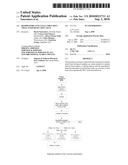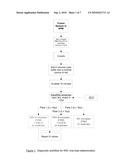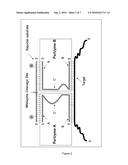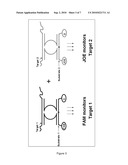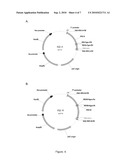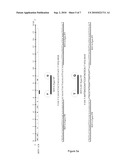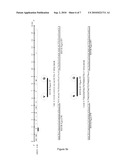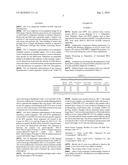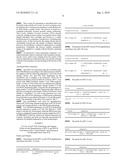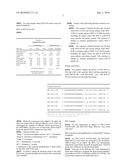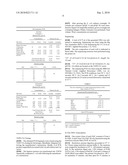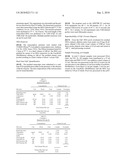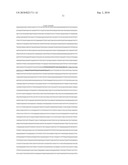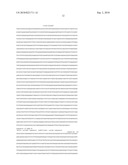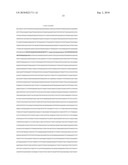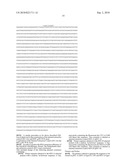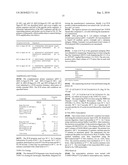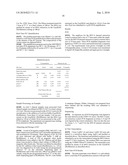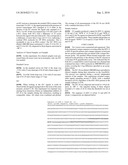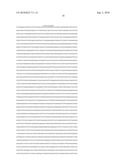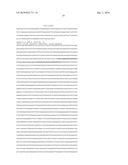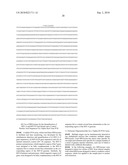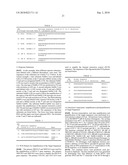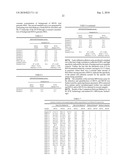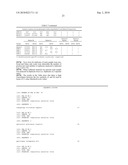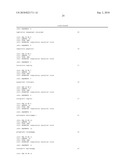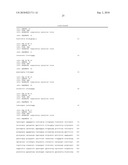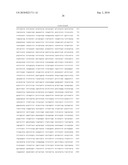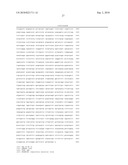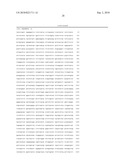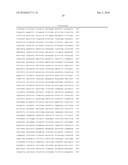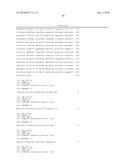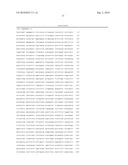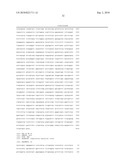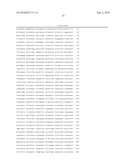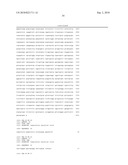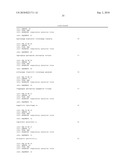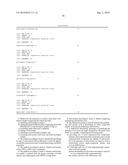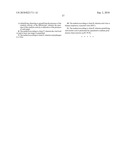Patent application title: Respiratory Syncytial Virus (RSV) Viral Load Detection Assay
Inventors:
David Nauwelaers (Kortrijk-Dutsel, BE)
Lieven Jozef Stuyver (Herzele, BE)
Lieven Jozef Stuyver (Herzele, BE)
Alison Velyian Todd (Glebe, AU)
Elisa Mokany (Woolooware, AU)
Paul Ean Young (Engadine, AU)
Assignees:
JOHNSON & JOHNSON RESEARCH PTY LIMITED
IPC8 Class: AC12Q168FI
USPC Class:
435 6
Class name: Chemistry: molecular biology and microbiology measuring or testing process involving enzymes or micro-organisms; composition or test strip therefore; processes of forming such composition or test strip involving nucleic acid
Publication date: 2010-09-02
Patent application number: 20100221711
Claims:
1. Method for the extraction of nucleic acids from a biological sample
comprising the following steps:a) obtaining said biological sample,b)
adding phosphate buffered saline comprising about 10% dithiothreitol to
said biological sample of step a),c) incubating under ultrasonic
conditions,d) adding a lysis buffer,e) obtaining a lysed biological
sample, andf) extracting said nucleic acid from said lysed biological
sample.
2. The method according to claim 1, wherein the incubating in step c) is performed with an ultrasonic Covaris S2 apparatus and the extraction in step f) is performed using EasyMAG procedure.
3. The method according to claim 1, wherein said nucleic acid is DNA or RNA from a pathogen.
4. The method according to claim 3, wherein said biological sample is selected from the group consisting of frozen sputum, naso-pharyngeal wash (NPW) or lung tissue.
5. The method according to claim 1, further comprising quantifying said nucleic acid.
6. The method according to claim 5, wherein the quantifying said nucleic acid is performed by multi component nucleic acid enzyme technology (MNAzyme).
7. A method for identifying, detecting or quantifying the presence of at least one target Respiratory Syncytial Virus (RSV) in a sample, comprising the following steps:(a) providing two or more oligonucleotide components wherein a first oligonucleotide component and a second oligonucleotide component are capable of self-assembly in the presence of said at least one target to form a catalytically active multi-component nucleic acid enzyme (MNAzyme);(b) contacting said two or more oligonucleotide components with said samplepermits the binding of said at least one target to said two or more oligonucleotide components andthe catalytic activity of the MNAzyme; and(c) identifying, detecting or quantifying the presence of the catalytic activity of the MNAzyme, wherein the presence of the catalytic activity is indicative of the presence of said target.
8. The method according to claim 7, wherein the viral load of said at least one target is quantified.
9. The method according to claim 3, wherein said pathogen is a virus.
10. The method according to claim 9, wherein said virus is human respiratory syncytial virus (RSV).
11. The method according to claim 5, wherein quantifying said nucleic acid is performed by quantitative realtime polymerase chain reaction (q-RT PCR).
Description:
[0001]The invention relates to a method for the extraction of nucleic
acids from biological samples e.g. tissue material or sputum derived from
human or animal species and the quantitative detection thereafter of said
nucleic acids e.g. in terms of viral load, more specifically RSV viral
load detection.
[0002]Human respiratory syncytial virus (RSV) is a negative sense, single-stranded RNA virus of the family Paramyxoviridae, which includes common respiratory viruses such as those causing measles and mumps. RSV is a member of the paramyxovirus subfamily Pneumovirinae. The virion is variable in shape and size (average diameter of between 120 and 300 nm), is unstable in the environment (surviving only a few hours on environmental surfaces), and is readily inactivated with soap and water and disinfectants.
[0003]Clinical features: Respiratory syncytial virus (RSV) is the most common cause of bronchiolitis and pneumonia among infants and children under 1 year of age. Illness begins most frequently with fever, runny nose, cough, and sometimes wheezing. During their first RSV infection, between 25% and 40% of infants and young children have signs or symptoms of bronchiolitis or pneumonia, and 0.5% to 2% require hospitalization. Most children recover from illness in 8 to 15 days. The majority of children hospitalized for RSV infection are under 6 months of age. RSV also causes repeated infections throughout life, usually associated with moderate-to-severe cold-like symptoms; however, severe lower respiratory tract disease may occur at any age, especially among the elderly or among those with compromised cardiac, pulmonary, or immune systems.
[0004]Epidemiologic features: RSV is spread from respiratory secretions through close contact with infected persons or contact with contaminated surfaces or objects. Infection can occur when infectious material contacts mucous membranes of the eyes, mouth, or nose, and possibly through the inhalation of droplets generated by a sneeze or cough. In temperate climates, RSV infections usually occur during annual community outbreaks, often-lasting 4 to 6 months, during the late fall, winter, or early spring months. The timing and severity of outbreaks in a community vary from year to year. RSV spreads efficiently among children during the annual outbreaks, and most children will have serologic evidence of RSV infection by 2 years of age.
[0005]Diagnosis: Diagnosis of RSV infection can be made by virus isolation, detection of viral antigens, detection of viral RNA, demonstration of a rise in serum antibodies, or a combination of these approaches. Clinical laboratories use either antigen detection assays to diagnose infection or nucleic acid amplification techniques to detect viral nucleic acids.
[0006]To demonstrate antiviral activity of pharmaceutical compounds on the market or in development, a sensitive viral load test or assay is needed to measure any drop in RSV viral load upon treatment with the compound(s).
[0007]Viral load is a measure of the severity of a viral infection, and can be calculated by determining the amount of virus in an involved body fluid, for example, it can be given in nucleic acid copies per milliliter of blood. Determination of viral load is part of the therapy monitoring during chronic viral infections for instance in immunocompromised patients.
[0008]Thus, there is an ongoing need in the art for simple, fast and cost effective methods for detecting, identifying and quantifying RSV in biological samples in terms of viral load. Biological samples can be obtained from any organism but are preferably from human or animal origin.
[0009]Preferably such a method must be able to process RNA derived from sputum and naso-pharyngeal wash (NPW). As a consequence thereof the detection assay, i.e. the RSV viral load detection assay, must include a sputum and NPW treatment method in preparation for RNA extraction from these samples. The assay must also be quantitative and able to distinguish between RSV-A and RSV-B in order not to miss a potential shift in RSV outbreak in a certain season.
[0010]The problem with sputum and NPW is that aliquots thereof are quite difficult to handle especially with regard to the extraction of nucleic acid material from said aliquots. Using the so-called EasyMAG® procedure (BioMerieux) for the extraction of nucleic acid material (such as RNA) from a sample, requires a more or less liquid solution for the extraction of nucleic acid from said solution. It is obvious that sputum, lung tissue but also NPW or cellular fractions containing RSV to be detected, do not qualify as a feasible liquid solution for further nucleic acid extraction thereof.
[0011]The solution is now found in a treatment method of samples, especially sputum and NPW, prior to the extraction of nucleic acid from said samples. After the extraction of nucleic acid from the samples, the nucleic acid is quantified e.g. viral load detection either by an additional real-time Polymerase Chain Reaction (q-RT-PCR) or additional by the so-called multi component nucleic acid enzyme technology (MNAzyme).
[0012]The inventive method for treating samples, whereafter an extraction method is used for isolation and subsequent detection of nucleic acids (RNA and/or DNA), is not limited to RSV RNA containing samples but can be applied for the detection of any viral (RNA or DNA) or bacterial (DNA) respiratory pathogen such as but not limited to Influenza A and B, Para-influenza types 1, 2, 3 and/or 4, meta-pneumovirus, rhinovirus and adenovirus.
[0013]In accordance with the present invention a method for the extraction of nucleic acids from a biological sample has been found comprising the following steps: [0014]a) obtaining a biological sample (e.g. tissue material from a human being or animal species, [0015]b) adding phosphate buffered saline/10% dithiothreitol to said tissue material of step a), [0016]c) incubating under ultrasonic conditions, [0017]d) adding lysis buffer, [0018]e) obtaining lysed tissue material and [0019]f) extracting said nucleic acid from said lysed tissue material.
[0020]Above mentioned step c) is preferably performed with a so-called Covaris S2 ultrasonic apparatus while the extraction step f) is preferably performed using the so-called EasyMAG procedure (BioMerieux).
[0021]Above mentioned step c) can alternatively be a mixing step using a Dyspomix apparatus specifically for (lung) tissue.
[0022]The nucleic acid can be either or both DNA or RNA from pathogens such as viruses or any other micro-organism while said tissue material can be either frozen sputum, naso-pharyngeal wash (NPW) or lung tissue wherein said virus is for instance human respiratory syncytial virus (RSV).
[0023]Said nucleic acid is further quantified by either the so-called quantitative real time Polymerase Chain Reaction technology (q-RT PCR) or by the so-called multi component nucleic acid enzyme technology (MNAzyme).
[0024]The combination of the above described extraction method of nucleic acid preferably from RSV containing patient samples with the further quantification by either q-RT-PCR or by the MNAzyme technology is also part of the present invention.
[0025]The invention further relates to a method for identifying, detecting or quantifying the presence of at least one target Respiratory Syncytial Virus (RSV) comprising the following steps: [0026](a) providing two or more oligonucleotide components wherein at least a first oligonucleotide component and at least a second oligonucleotide component are capable of self-assembly in the presence of said target to form a catalytically active multi-component nucleic acid enzyme (MNAzyme); [0027](b) contacting said oligonucleotide components with a sample putatively containing said at least one target under conditions: [0028](1) permitting the binding of said target to said oligonucleotide components and [0029](2) permitting the catalytic activity of the MNAzyme; and [0030](c) identifying, detecting or quantifying the presence of the catalytic activity of the MNAzyme, wherein the presence of the catalytic activity is indicative of the presence of said target.
[0031]Preferably the viral load of the target, RSV, is quantified by the above-mentioned method.
[0032]For a detailed explanation of q-RT-PCR technology specific reference is made to EP 543, 942 filed by F. Hoffmann--La Roche AG, Switzerland, while the MNAzyme technology is explained in great detail in patent application PCT/AU2006/001473 filed by Johnson & Johnson Research Pty Limited, Australia) and both documents are herewith incorporated by reference for sake of detailed explanation of both technologies.
[0033]Regarding the MNAzyme technology a general description of said technology is given hereafter.
[0034]MNAzymes (patent application PCT/AU2006/001473 by Johnson & Johnson Research Pty Limited, Australia) are novel catalytic nucleic acids based on DNAzymes. MNAzymes consist of two or more oligonucleotide sequences (e.g. partzymes) which, only in the presence of a MNAzyme assembly facilitator molecule (e.g. target which may be quantitatively amplified), form an active nucleic acid enzyme that is capable of catalytically modifying a substrate, for example a reporter substrate. An exemplary MNAzyme comprising partzyme A and partzyme B is depicted in FIG. 2. With reference to FIG. 2, DNA partzymes A and B each bind to a target, i.e. the MNAzyme assembly facilitator molecule (e.g., through Watson-Crick base pairing with a nucleic acid target). The MNAzyme only forms when the sensor arms of partzymes A and B hybridize adjacent to each other on the target. The substrate arms of the MNAzyme engage the reporter substrate, the cleavage of which is catalyzed by the catalytic core of the MNAzyme, formed by the interaction of the catalytic domains of partzymes A and B. The MNAzyme cleaves the substrate between a fluorophore and a quencher dye pair, thus generating signal. Cleavage of a DNA/RNA chimera (reporter substrate) is exemplified in the drawing. The term "MNAzyme" is also referred to as "multi-component nucleic acid enzyme". An MNAzyme may also comprise a stabilizing oligonucleotide, which provides stability of the MNAzyme by interacting with an assembly facilitator or substrate. It is apparent that formation of an MNAzyme requires the assembly of at least the partzyme components with the target (or assembly facilitator), as well as the binding of a reporter substrate, for catalytic activity to be detectable, and that the absence of any of these components will result in a lack of catalytic activity.
[0035]The reporter substrate used with the MNAzymes can be labeled by any of a large variety of means including, for example, fluorophores (with or without one or more additional components, such as quenchers), radioactive labels, labeling with biotin (e.g. biotinylation) or chemiluminescent labels. Reporter substrates for catalytic nucleic acids may also include protein or nucleic acid enzymes, for example, covalently attached to their termini.
[0036]The reporter substrates used with the MNAzymes may be generic reporter substrate systems, which allow rapid assay development by allowing facile design changes to create new MNAzymes which recognize different targets.
[0037]The substrate arm portion and the catalytic core portion of the partzymes may remain unchanged, with changes only to the sensor arm portion of one or more partzymes required for new targets. Generic substrate sequences are provided and the same substrate can therefore be incorporated in assays for many different targets. Further, the same substrate can be incorporated into the methods in various embodiments herein, including assays where the substrate is free in solution or is tethered or attached to a support. A series of generic substrates can be used in a multiplex reaction allowing simultaneous detection of multiple targets. MNAzyme strategies using generic substrates offer a major advantage over technologies such as TaqMan® or Beacons which require the design and use of probes specific for each new target.
[0038]As described in more detail below, MNAzymes have an advantageous property in certain embodiments of being able to utilize a universal or generic reporter substrate. Such a substrate is shown in FIG. 2 in a presently preferred configuration wherein the reporter substrate comprises both a detectable portion and a quencher portion. The quencher portion is adapted to diminish or eliminate a detectable signal from the detectable portion of the substrate until the MNAzyme cleaves the substrate. For example, the quencher portion may comprise "Black Hole Quencher 1" (BHQ1) or "Black Hole Quencher 2" (BHQ2). Thus, the MNAzyme cleaves the reporter substrate between the detectable portion and the quencher portion allowing the two portions to separate in solution, thereby allowing the detectable signal to appear or increase as the quencher portion is distanced from, or effectively removed from the local environment of the detectable portion.
[0039]The use of the generic or universal reporter substrate is enabled through the design of the MNAzyme's component partzymes. By altering only the sensor arms of the partzymes, but by leaving the substrate arms unchanged, a large variety of MNAzymes specific for each of a plurality of targets can be designed all of which utilize a universal reporter substrate for detection. The skilled artisan will appreciate the advantages that this offers in terms of eliminating the need for customized or unique substrates for each target. Each new target requires only one or more changes in one or more of the sensor arm portions; the substrate arm portion and the catalytic core portion can remain constant. Thus, a single reporter substrate can be used for a single target using an MNAzyme, and multiple targets in a series of assays using altered MNAzymes. A plurality of reporter substrates allows multiplexing to detect multiple targets in a single assay using multiple MNAzymes, one for each target. Such multiplexed methods of using MNAzymes are readily accomplished in solution or with attachment to a support system. It is contemplated herein that multiplexed assays can thus be accomplished in systems involving attaching one or more of the reporter substrate, or the MNAzyme partzymes or assembly facilitator, or additional enzyme activities, to a support as described herein.
[0040]Substrates can be modified by an MNAzyme thereby providing a detectable effect. In the detection process, the reporter substrate modification by an MNAzyme may involve, for example, cleavage, ligation, porphyrin metallation, and formation of carbon-carbon bonds, ester bonds or amide bonds. As a consequence of the reporter substrate modification by an MNAzyme, a detectable effect is generated and the magnitude of the effect may therefore be indicative of the quantity of the target sought to be measured. The detectable effect may be detected by a variety of methods, including fluorescence spectroscopy, surface plasmon resonance, mass spectroscopy, NMR, electron spin resonance, polarization fluorescence spectroscopy, circular dichroism, immunoassay, chromatography, radiometry, photometry, scintigraphy, electronic methods, UV, visible light or infra red spectroscopy, enzymatic methods or any combination thereof.
[0041]MNAzymes may contain one or more substitutions such as analogues, derivatives, modified or altered bases, ribonucleotides, alterations of the sugar or phosphate backbone, various deletions, insertions, substitutions, duplications or other modifications, or any combination of these, well known to those skilled in the art. Such modifications, substitutions, deletions, insertions, etc may be made in the sensor and/or substrate arms and/or in the catalytic core portions such that the molecule retains catalytic activity. Substitutions and modifications to arms that bind the substrate or assembly facilitator may be well tolerated and in fact are the basis of allowing tailoring of the molecules to different substrates/assembly facilitators. For example, modification of the sensor arms will allow tailoring to different assembly facilitators, while modification of the substrate arms will allow tailoring to different substrates.
[0042]The skilled artisan will appreciate that MNAzymes comprise either deoxyribonucleotides or ribonucleotides, or even both. Those MNAzymes comprising at least one and more preferably, all, deoxyribonucleotide component oligonucleotides are presently preferred. Also preferred are those MNAzymes comprising at least one deoxyribonucleotide base, or its analogue, within the catalytic core of the MNAzyme. Even more preferred are those embodiments where such a base is required for catalytic activity.
[0043]A basic example of a MNAzyme structure is depicted in FIG. 2. The structure shown comprises partzyme A and partzyme B which have base-paired with an MNAzyme assembly facilitator molecule, shown here simply as Target. Partzymes A and B by interacting with Target, have allowed the catalytic core to come into close proximity and thereby form. The substrate arms of the MNAzyme have interacted with and base-paired with a substrate, here Reporter Substrate. Thus the MNAzyme has self-assembled and this process is facilitated through the presence of the MNAzyme assembly facilitator molecule Target. In the absence of Target, no MNAzyme will form. Modification (in this case, cleavage) of the substrate is catalyzed by the catalytic core of the MNAzyme at the MNAzyme Cleavage Site within the substrate denoted by the vertical arrow. The substrate in this particular embodiment of the invention comprises a detectable portion having a detectable signal, for example fluorophore F, and a quencher portion having a quenching effect on the detectable signal F through the action of quencher Q. Upon cleavage at the MNAzyme Cleavage Site, there is a substantial increase in detectable signal, here fluorescence, which is readily detected or quantified.
[0044]More specifically, the partzyme A and partzyme B, shown in FIG. 2, each comprise a substrate arm portion, a catalytic core portion, and a sensor arm portion. In the presence of a target, the sensor arm portions of partzyme A and partzyme B can begin to hybridize to, and base pair with complementary portions of the target, for example a DNA or RNA sequence. Upon contacting the target in this fashion, the MNAzyme self-assembles forming a catalytic core, which can modify a substrate which is bound by the substrate arms. Preferably the presence of the MNAzyme is detected through the detection or measurement of its catalytic activity. The substrate arms of the thus assembled MNAzyme can engage a substrate, for example the reporter substrate shown in FIG. 2, through the interaction of the complementary sequences on the substrate arms and the substrate. Once the substrate is so engaged with the substrate arms, the catalytic core can promote the modification (eg. cleavage) of the substrate, which can in turn be measured or detected, directly or indirectly.
[0045]Multiple MNAzymes are useful in the present invention as they allow detection of related sequences differing by as little as a single nucleotide. Similarly, a unique reporter substrate is required to detect each of the several targets. In some cases, to multiplex the method requires the use of a distinct or unique detectable signal for each reporter substrate to facilitate the design of the method.
[0046]The target nucleic acid can be amplified in accordance with a procedure for amplifying that nucleic acid (i.e. DNA or RNA). Preferably, standard methods of in vitro amplification are used. The amplicons generated during the amplification serve as targets for an MNAzyme, thus MNAzyme activity is indicative of the presence of the target. The skilled artisan will appreciate that such monitoring can be conducted in a single vessel under conditions that permit both the amplification and the MNAzyme assembly and catalytic activity, or the MNAzyme assay can be conducted subsequent to, or at time points throughout the amplification, by removing samples at the end or during the course of the amplification reactions.
[0047]The method for detecting the presence of at least one target or assembly facilitator may further comprise providing at least a third and fourth oligonucleotide component, wherein said at least third and at least fourth oligonucleotide component are capable of self assembling in the presence of at least one additional target or assembly facilitator to form at least one additional catalytically active MNAzyme, and wherein at least one additional reporter substrate is present in the sample, said additional reporter substrate is capable of being modified only by the additional MNAzyme, wherein said modification provides said additional detectable effect.
[0048]Standard curves of threshold cycle (Ct) values over time for the target(s) are obtained and plotted onto the standard curves, generally obtained from a control or housekeeping gene, and the proportion of a given target in the viral population or in a given environment is visualized and calculated.
[0049]The protocols and products of the present invention may be used for diverse diagnostic, clinical, toxicological, research and forensic purposes including, drug discovery, designing patient therapy, drug efficacy testing, and patient management. The present methods may be used in combination with other assays. The results may be implemented in computer models and databases.
[0050]Additionally, the protocols and products of the present invention also allow monitoring of the effect of anti-RSV compounds on viral load.
DEFINITIONS
[0051]The terms "assembly facilitator molecule", "assembly facilitator", "MNAzyme assembly facilitator molecule", "facilitator" and "MNAzyme assembly facilitator" as used herein refer to entities that can facilitate the self-assembly of component partzymes to form a catalytically active MNAzyme. In preferred embodiments an assembly facilitator is required for the self-assembly of an MNAzyme. An assembly facilitator in some embodiments comprises a target such as a nucleic acid or non-nucleic acid analyte. Assembly facilitator molecules may comprise one or more regions or molecules that may pair with, or bind to, one or more oligonucleotide "partzymes," which constitute components or portions of an "MNAzyme". It is not required that the assembly facilitator interact with, pair with, or bind to each component partzyme or oligonucleotide provided that it interacts with, pairs with, or binds to, at least one of the component partzymes of an MNAzyme. As used herein, MNAzyme assembly facilitator molecules are intended to encompass the broadest range of constituents, which can facilitate self-assembly of an MNAzyme. In some embodiments, an assembly facilitator may comprise a nucleic acid. In other embodiments, an assembly facilitator may comprise any cell or any portion thereof, for example, any eukaryotic or prokaryotic cell, a virus, prion, yeast or fungus, or any other molecule, for example, including but not limited to a protein, polypeptide, peptide or nucleic acid. In other embodiments, an assembly facilitator may comprise a virus, prion, yeast or fungus, or any other molecule, for example, including but not limited to glycoproteins, lipids, lipoproteins, entire organisms, cells, viruses, bacteria, archaea, fungi, antibodies, metabolites, pathogens, toxins, contaminants, poisons, small molecules, polymers, metal ions, metal salts, prions or any derivatives, portions or combinations thereof.
[0052]The term "target" as used herein includes any natural or synthetic entity, constituent or analyte, which is sought to be detected, identified or quantified by a particular MNAzyme(s). Targets therefore encompass the broadest range of detectable entities, constituents or analytes for which methods of sensitive detection, identification and/or quantification are desirable. In some embodiments, a target comprises an assembly facilitator. Some exemplary targets include, but are not limited to, protein, polypeptide, peptide or nucleic acid, glycoproteins, lipids, lipoproteins, entire organisms, cells, viruses, bacteria, archaea, yeast, fungi, antibodies, metabolites, pathogens, toxins, contaminants, poisons, small molecules, polymers, metal ions, metal salts, prions or any derivatives, portions or combinations thereof. Other targets are also contemplated for use herein.
[0053]The terms "substrate", "substrate molecule" and "chemical substrate" as used herein include any molecule which is capable of being recognized, and acted upon or chemically modified by a catalytic molecule. In particular embodiments, a substrate may be recognized and modified by an enzyme. In other embodiments, a substrate may be recognized and modified by a catalytic nucleic acid molecule. The chemical modification of a substrate can be measured by the appearance of, or increase in, a product of the modification reaction, or by the disappearance of, or decrease in, a substrate of the modification reaction(s). A particular catalytic molecule may recognize one or more different substrate molecules provided each substrate molecule has at least a minimum structure, which is recognizable for catalytic activity by the catalytic molecule.
[0054]A "reporter substrate", "reporter probe" or "reporter probe substrate" as used herein is a substrate that is particularly adapted to facilitate measurement of either the disappearance of a substrate or the appearance of a product in connection with a catalysed reaction. Reporter substrates can be free in solution or bound (or "tethered"), for example, to a surface, or to another molecule. A reporter substrate can be labelled by any of a large variety of means including, for example, fluorophores (with or without one or more additional components, such as quenchers), radioactive labels, labelling with biotin (e.g. biotinylation) or chemiluminescent labels. Reporter substrates for catalytic nucleic acids may also include protein or nucleic acid enzymes, for example, covalently attached to their termini.
[0055]As used herein, the terms "partzyme", "component partzyme" and "component oligonucleotide" refer to a DNA-containing or RNA-containing or DNA-RNA-containing oligonucleotide, two or more of which, only in the presence of a MNAzyme assembly facilitator molecule, can together form an "MNAzyme." In certain preferred embodiments, one or more component partzymes, and preferably at least two, may comprise three regions or domains: a "catalytic" domain, which forms part of the MNAzyme's catalytic core that catalyzes a chemical modification; a "sensor arm" domain, which may associate with and/or bind to an assembly facilitator (e.g. a target); and a "substrate arm" domain, which may associate with and/or bind to a substrate. A depiction of these regions or domains can be seen, for example, in FIG. 2. A partzyme may comprise one or more molecules.
ABBREVIATIONS
[0056]MNAzyme: multi-component nucleic acid enzyme, or multipartite nucleic acid enzyme; [0057]DNAzyme: deoxyribonucleic acid enzyme; [0058]RNAzyme: ribonucleic acid enzyme, or ribozyme; [0059]PCR: polymerase chain reaction; [0060]dH2O: deionized distilled water; [0061]F: fluorophore; [0062]Q: quencher; [0063]JOE or 6-JOE: 6-carboxy-4',5'-dichloro-2',7'-dimethoxyfluorescein; [0064]FAM or 6-FAM: 6-Carboxyfluorescein; [0065]BHQ1: Black Hole Quencher 1; [0066]BHQ2: Black Hole Quencher 2.
FIGURES
[0067]FIG. 1 is a diagnostic workflow for RSV viral load determination.
[0068]FIG. 2 is a depiction of an exemplary design for an MNAzyme, wherein substrate arm portions (A) of partzymes A and B bind to a Reporter substrate, to which is attached a fluorescent tag (left) and a quencher (right). Catalytic core portions (C) are located between substrate arm portions (A) and sensor arm portions (B). Upon binding of sensor arm portions (B) to a Target, the Reporter substrate is cleaved at the MNAzyme Cleavage Site, thereby increasing fluorescence.
[0069]FIG. 3: Schematic representation of an exemplary multiplex analysis of multiple targets: Two or more targets can be simultaneously detected using two or more substrates, each specific for one MNAzyme. Substrates are preferably labeled with different fluorophores. In this example, Target 1 can be detected by monitoring the increase in FAM fluorescence and Target 2 can be detected by monitoring the increase in JOE fluorescence. Q: quencher; FAM, JOE: fluorophores.
[0070]FIG. 4: Schematic representation of the External Quantification Control sequences cloned in the TOPO-TA vector (Invitrogen, Merelbeke): EQC-A (A) and EQC-B (B). The vectors indicate the T7 promotor and the flanking primers used to generate the amplicon that was cloned. Also shown are the two primers used during the q-RT-PCR assay in each vector as well as the location of the NdeI restriction site used to linearize the vectors before transcription.
[0071]FIG. 5a/b: Schematic representation of the internal extraction control sequences. The q-RT-PCR amplification uses an RSV-A and RSV-B conserved and specific sequence in the RSV genome. These sequences are located in the F-gene for RSV-A (1) and the N-gene for RSV-B (3). The primers to amplify the RSV RNA or the RSV internal extraction control are identical per sub-strain: The sequences in between the primers are probe-specific: RSV-A RNA=RSVA-Fgen-TP probe (1), RSV-A internal extraction control=RSVA-EC-Fgen-TP probe (2); RSV-B RNA=RSVB-Ngen-TP probe (3), RSV-B internal extraction control=RSVB-EC-Ngen-TP probe (4).
[0072]FIG. 6: Schematic representation of the Internal Extraction Control (IEC) sequences cloned in the TOPO-TA vector (Invitrogen, Merelbeke): pIEC-A (A) and pIEC-B (B). The vectors indicate the T7 promotor, the two primers and the probe location for each vector as well as the location of the ApaLI restriction sites used to linearize the vectors before transcription.
[0073]The following non-limiting examples help to illustrate the principles of the invention.
EXAMPLES
Example 1
[0074]Sputum and NPW was received from various sources (REGA, Leuven, Belgium; O. L. V. Ziekenhuis, Aalst, Belgium). Sputa and NPW samples used in these experiments when not infected with RSV were spiked with an RSV virus stock (RSV-A: RSV-GFP 011828) whenever applicable.
[0075]Additionally a Dyspomix (Wilten Instruments, Cat no 900.021.00, Berchem, Belgium), an AFA (Covaris, Hoddesdon, UK) and an ABI9700HT (Applied Biosystems, CA, USA) were used during the course of these experiments.
Sample Processing in Preparation of Automated RNA Extraction
[0076]A method was developed for the preparation of different RSV samples for automated RNA extraction (see FIG. 1 for the schematic diagnostic workflow).
[0077]Different kinds of processing could occur with different kinds of samples (as described in Table 1).
TABLE-US-00001 TABLE 1 Overview of different sample types and different preparation methods. Sputum NPW Bal (mouse) Virus Culture Virus Culture Lung (human) (human) fluid (Supernatant) (Cell fraction) tissue (rat) Covaris S2 Yes Yes Yes Yes Yes No Dyspomix Yes Yes Yes Yes Yes Yes EasyMAG No Yes Yes Yes No No NPW: Nasopharyngeal Wash; BAL: Bronchoalveolar Lavage
[0078]Samples were stored in-house at -80° C. The weight of the frozen samples was determined while still frozen, 1 volume of PBS/10% DTT was added to the samples with a minimal final volume of 2.2 ml (in Becton Dickinson 14 ml polypropylene round-bottom tube, ref number 352059 (25 per bag, sterile)). Samples with an estimated initial volume larger than 1.5 ml were first transferred to a 50 ml tube before addition of one volume PBS/10% DTT by slightly warming the 15 ml tube until the frozen sample could be slid into the 50 ml Falcon tube (Red cap). The frozen sample/PBS-10% DTT was placed in the Covaris S2 instrument and processed with SonoLAB Single v2.4.3 with the following settings:
Mode=Power Tracking, Number of Cycles=10, Bath Temperature Limit=15° C.
Treatment 1: "Duty Cycle"=20%, "Intensity"=10 and "Cycles/Burst"=100 for 30 s.
Treatment 2: "Duty Cycle"=0.1%, "Intensity"=0.1 and "Cycles/Burst"=50 for 10 s.
[0079]Mostly one (1) cycle was sufficient to dissolve the sample, if not, extra cycles were added as needed.
[0080]The cooling of the Covaris was set at 1° C.
[0081]After Covaris treatment, 4 initial sample volumes of Lysis buffer (EasyMAG, BioMerieux) were added and incubated for 10 minutes.
[0082]The Covaris S2 instrument as described above can be found on the website of Covaris viz www.covarisinc.com. In summary the Covaris process produces a controlled acoustic field inside a sealed vessel. The process is based on a computer-controlled, focused acoustic energy technology. The Covaris Adaptive Focused Acoustics (AFA) process works by sending acoustic energy wave packets from a dish-shaped transducer that converges and focuses to a small-localized area (it is sometimes visualized as a vibrating loudspeaker cone). At this focal point, the energy density may be controllably focused into the sample of interest which has proven to be beneficial to numerous applications of sample preparation. Essentially, the process enables mechanical energy to be applied to a sample without directly contacting the sample.
[0083]An advanced Covaris instrument comprises a so-called intensifier which is attached to the transducer producing the waves. Said waves starting from the centre of the concave intensifier are reflected by the cone and the obtained vertical waves produces an extra heating at the bottom of the vessel.
Automated RNA Extraction
[0084]The RNA was extracted using the EasyMAG platform (BioMerieux) according to the instructions provided by the supplier with the following adaptation: 3 ml of the lysed sample volume was used (No lysis dispensing on the EasyMAG), per 8 samples to be extracted: 110 μl IEC-B (internal extraction control for RSV-B, stored in -80° C.) was mixed with 4400 EasyMAG Buffer 3 and 5500 magnetic beads. A total of 125 μl of this mix was dispensed in separate wells using the pre-programmed settings number 2 of the EasyMAG dispensing pipet. Using the pre-programmed settings number 3 of the EasyMAG dispensing pipet 100 μl of this mix was added to each sample. Elution occurred in 110 μl (Buffer 3, EasyMAG). As soon as the extraction was completed, the q-RT-PCR technology or MNAzyme technology was performed as described in Example 2 (A) and (B) respectively. The remainder of the RNA was stored at -80° C.
[0085]Two possibilities were used for quantification, either q-RT PCR using Taqman technology (q-RT PCR technology and Taqman probes) or the MNAzyme technology.
[0086]For a detailed explanation of q-RT-PCR technology specific reference is made to EP 543, 942 filed by F. Hoffmann-La Roche AG, Switzerland, while the MNAzyme technology is explained in great detail in patent application PCT/AU2006/001473 filed by Johnson & Johnson Research Pty Limited, Australia) and both are herewith incorporated by reference for detailed explanation of both technologies.
Example 2
(A) Use of q-RT PCR Technology and Taqman Probes for the Quantification of RSV-A and RSV-B Viral Strains and a Control Nucleic Acid Sequences Via Monoplex Real Time PCR
Probes and Primers:
[0087]The primers for the RSV-A q-RT-PCR amplification (and hence also pIEC-A) were:
TABLE-US-00002 Oligonucleotide Sequence RSV-A-Fgen-FW 5'-CTGTGATAGA RTTCCAACAA SeqID AAGAACA-3' No. 1 RSV-A-Fgen-RV 5'-AGTTACACCT GCATTAACAC SeqID TAAATTCC-3' No. 2
[0088]The primers for the RSV-B q-RT-PCR amplification (and hence also pIEC-B) were:
TABLE-US-00003 Oligonucleotide Sequence RSV-B-Ngen-FW 5'-GGCTCCAGAA TATAGGCATG SeqID ATTC-3' No. 3 RSV-B-Ngen-RV 5'-TGGTTATTAC AAGAGCAGCT SeqID ATACACAGT-3' No. 4
[0089]The probe for RSV-A was:
TABLE-US-00004 Probe Sequence RSV-A-Fgen-TP FAM 5'-CAGACTACTAGAGATT SeqID No. 5 ACC-3' NFQ-MGB* *NFQ-MGB: Non-Fluorescent Quencher - Minor Groove Binding Sequence
[0090]The probe for RSV-B was:
TABLE-US-00005 Probe Sequence RSV-B-Ngen-TP FAM 5'-TATCATCCCAC SeqID No. 6 AGTCTG-3' NFQ-MGB
[0091]The probe for pIEC-A was:
TABLE-US-00006 Probe Sequence RSV-A-EC-Fgen-TP FAM 5'-AATGACCAATCCATA SeqID No. 7 CGCA-3' NFQ-MGB
[0092]The probe for pIEC-B was:
TABLE-US-00007 Probe Sequence RSV-B-EC-Ngen-TP FAM 5'-TACCGTACTCTAG SeqID No. 8 CCTA-3' NFQ-MGB
[0093]For each sample, three q-RT-PCR mixes were prepared in duplicate:
RSV-A, RSV-B and IEC
TABLE-US-00008 [0094]Samples 1 Reaction Vol. (μl) 30 Concentration Volume for (μl) Mix item Unit Stock Final 1 sample X samples Rnase free water 0.77 2.31 Yeast tRNA ng/ml 10000 120 0.360 1.08 2x Reaction X 2.00 1.000 15.000 45.00 buffer Euroscript RT kU/ml 50.00 0.250 0.150 0.45 Probe RSV μM 25.00 0.100 0.120 0.36 RSV primer FW μM 20.00 0.900 1.350 4.05 RSV primer RV μM 20.00 0.900 1.350 4.05 MgCl2 μM 50.00 1.500 0.900 2.70 Total Volume Mix (μl) 60.00 Volume Mix/Tube (μl) 20.00 Total RNA RSV-A 10.00
[0095]When all components were added to the plate, the plate was sealed with an Optical Adhesive Cover (ABI) and centrifuged for 1 minute at 1500 rpm. Before processing on the ABI7900HT, the plate was covered with a MicroAmp® Snap-On Optical Film Compression Pad (ABI).
[0096]Thermal Profile was:
"Stage 1" reverse transcriptase reaction: 48° C., 30 minutes"Stage 2" activation of polymerase: 95° C., 10 minutes"Stage 3": 45 repeats:95° C. denaturation, 15 seconds60° C. elongation, 1 minuteConstruction of the External Quantification Control (EQC) for the RSV q-RT PCR Assay
[0097]In order to define the dynamic range of the q-RT-PCR assay, external quantification controls were constructed. This included: [0098]Design of the following plasmid constructs containing: [0099]The sequence situated between the forward (EQC-RSV-A-FW) and reverse primer (EQC-RSV-A-RV) covering a region of RSV-A of 1004 base pairs including the region where the RSV-A q-RT-PCR assay primers and probes anneal. This construct is labeled as external quantification control RSV-A (pEQC-A). [0100]The sequence situated between the forward (EQC-RSV-B-FW) and reverse primer (EQC-RSV-B-RV) covering a region of RSV-A of 1399 base pairs including the region where the RSV-B q-RT-PCR assay primers and probes anneal. This construct is labeled as external quantification control RSV-B (pEQC-B).
Primers and Probes
[0101]The primers ordered the pEQC-A (EQC-RSV-A-FW, EQC-RSV-A-RV and EQC-RSV-A-RVret) and pEQC-B (EQC-RSV-B-FW, EQC-RSV-B-RV and EQC-RSV-B-RVret) constructs are described hereunder.
TABLE-US-00009 Oligonucleotide EQC-RSV-A-FW 5'-AATCAAAATAAACTCTGGGGC-3' bp 5631-5651* SeqID No. 9 EQC-RSV-A-RV 5'-GTTGGTTGTACATAGAGGGG-3' bp 6634-6615* SeqID No. 10 EQC-RSV-A-RVret 5'-TACATGTTTCAGCTTGTGGG-3' bp 6734-6715* SeqID No. 11 EQC-RSV-B-FW 5'-ATATTTATCAATCATGGCGGG-3' bp 908-928** SeqID No. 12 EQC-RSV-B-RV 5'-CTACATCATCTTCTTTGGGG-3' bp 2306-2286** SeqID No. 13 EQC-RSV-B-RVret 5'-GTGCCAGATGTTATCGGGC-3' bp 2524-2507** SeqID No. 14 *Positions are base on the Long strain (AY911262, RSV-A) **Positions are based on AY353550 (RSV-B)
RSV Samples
[0102]For this experiment an aliquot of RSV-A-GFP (GST011828) and RSV-B-P3-Hep2 (REGA) virus stock were used.
RNA Extraction and Amplification of Desired RSV Genome Fragments
[0103]An RSV-A-GFP (GST011828) and RSV-B-P3-Hep2 (REGA) virus stock was extracted on the EasyMAG: 1000 μl input, 55 μl output. The RNA was subsequently submitted to an RT-hemi-nested PCR amplification. The PCR mixes and conditions are specified hereunder.
[0104]Overview of the different (RT) PCR amplification mixes and conditions to generate the hemi-nested amplification products for RSV-A (1004 bp) and RSV-B (1399 bp). The exact primer sequences are mentioned above.
TABLE-US-00010 Mix preparation PCR RT-PCR # Samples 1 Reaction Vol. (μl) 35 Concentration Volume for (μl) Mix Item Unit Stock Final 1 sample x samples Rnase Free water 6.10 12.20 2x Reaction X 2.00 1.000 17.50 35.00 buffer HiFi Primer FW μM 20.00 0.200 0.35 0.70 Primer RVret μM 20.00 0.200 0.35 0.70 SuperscriptTM U/μl 100.00 2.000 0.70 1.40 III HiFi Total Volume Mix (μl) 25.00 50.00 Total Volume RNA (μl) 10.00 thermal cycling step temp. (° C.) time cycles 1 53 30' 2 94 2' 3 92 15'' 40 4 55 30'' 5 68 1'30'' 6 68 7' 7 4 hold Heminested # Samples 1 Reaction Vol. (μl) 50 Concentration Volume for (μl) Mix Item Unit Stock Final 1 sample x samples Rnase Free water 39.17 78.34 PCR Buffer X 10.00 1.000 5.00 10.00 (15 mM MgCl2) dNTPs mM 25.00 0.200 0.40 0.80 Primer FW μM 20.00 0.200 0.50 1.00 Primer RV μM 20.00 0.200 0.50 1.00 Expand ®HF PCR U/μl 3.50 0.030 0.43 0.86 Total Volume Mix (μl) 46.00 92.00 Total Volume 4.00 RT-PCR mix (μl) thermal cycling step temp. (° C.) time cycles 1 94 2 min 2 94 15'' 35 3 60 30'' 4 68 1' 5 68 7' 6 4 hold
TOPO-TA Cloning
[0105]The obtained PCR fragments were cloned using the TOPO TA cloning kit (Invitrogen, Merelbeke, Belgium) following the manufacturer's instructions. Briefly, 4 μl PCR product (unpurified) was mixed with 1 μl salt solution and 1 μl vector.
[0106]The ligation reaction was transformed into TOP10 chemically competent E. coli cells following the manufacturer's instructions.
[0107]After growing the E. coli cultures overnight, 10 colonies per construct (pEQC-A and pEQC-B) were transferred to liquid LB/Ampicillin medium, grown overnight and a miniprep (Qiagen, Hilden, Germany) was performed. Final volume=50 μl, concentration not measured.
Sequencing
[0108]A total of 0.75 μl of the generated DNA was submitted to sequencing. Sequencing was done using the Big Dye Terminator (BDT) Cycle Sequencing Kit v3.1 (Cat no. 4337457, Applied Biosystems, CA, USA).
[0109]The mix composition of each well is indicated in below table. The sequencing reactions were performed using the primer set
"T3" (5'-ATTAACCCTCACTAAAGGGA-3') (SeqID No. 15) and
[0110]"T7" (5'-TAATACGACTCACTATAGGG-3') (SeqID No. 16) which are located on the TOPO-TA vector.
[0111]The sequencing PCR was done using the 9800 Fast Thermal Cycler (Applied Biosystems (ABI), Cat. no. 4356204, CA, USA). The PCR conditions were 96° C. for 5 seconds, 50° C. for 5 seconds, 60° C. for 1 minute and 15 seconds and this for 25 cycles in total followed by a final hold at 12° C.
TABLE-US-00011 TABLE The mix composition of a single sequencing reaction, with a final volume of 5.75 μl. Sequencing Mix preparation (μl): x wells 1 well 20 BDT 0.25 5.25 μl DB 1.25 26.25 μl Water 1.50 31.50 μl Primer* 2.00 42.00 μl tot mix 5.00 105.00 μl amplicon 0.75 Speed PCR program: 96° C. 5'' # cycli 50° C. 5'' 25 60° C. 1'15'' 12° C. hold (*T7 or T3 sequencing primer was used). "BDT" = Big Dye Terminator, "DB" = Dilution Buffer
In Vitro RNA Transcription
[0112]One correct clone of each EQC construct (Clone 6 for EQC-A and Clone 3 for EQC-B) was linearized using the restriction enzyme NdeI (FIGS. 4 A & B).
[0113]Restriction enzyme digestion proceeded at 37° C. for 3 hours using restriction enzyme buffer 4. The reactions were stopped by incubation at 65° C. (20 minutes) and purified. To the restriction digest mix, 1/20 volumes of 0.5M EDTA (1 μl), 1/10 volumes of NaOAC (2 μl) and 2 volumes of EtOH (40 μl) were added. The mixture was placed at -20° C. for minimum 15 minutes, and then spun for 15 minutes at maximum speed. The supernatant was discarded and the pellet was dissolved in 50 μl TE buffer. The linearized constructs were then transcribed using the MEGAshortscript® T7 Kit (Ambion, Cat. no. 1354, Texas, USA). The reaction mixtures were incubated at 37° C. for 4 hours. The total length of the transcribed RNA was predicted to be 1250 (EQC-A) and 1600 (EQC-B) nucleotides. Multiple parallel reactions were set up for each EQC.
DNA Removal
[0114]The transcription mixtures were treated with TURBO DNase® (2 μl added to transcription mix, Ambion, Cat. No. 2238, Texas, USA). The DNase treatment lasted for 1 hour at 37° C. in a final volume of 100 μl. The RNA was purified by means of an RNA extraction on the EasyMAG (BioMerieux) eluting in 100 μl The purified eluates were pooled resulting in a final volume of about 1 ml per EQC.
Real-Time EQC Quantification
[0115]The purified transcripts were submitted to a real-time PCR quantification either in the presence or the absence of the RT enzyme. The mix compositions of the various mixes can be found hereafter:
TABLE-US-00012 EQC-A # Samples 1 Reaction Vol. (μl) 30 Concentration Volume for (μl) Mix item Unit Stock Final 1 sample X samples Rnase free water 1.670 5.01 Yeast tRNA ng/ml 10000 120 0.360 1.08 2x Reaction X 2.00 1.000 15.000 45.00 buffer Euroscript RT kU/ml 50.00 0.250 0.150 0.45 Probe RSV-A μM 25.00 0.100 0.120 0.36 RSV-A primer FW μM 20.00 0.900 1.350 4.05 RSV-A primer RV μM 20.00 0.900 1.350 4.05 Total Volume Mix (μl) 60.00 Volume Mix/Tube (μl) 20.00 Total RNA 10.00 EQC-B # Samples 1 Reaction Vol. (μl) 30 Concentration Volume for (μl) Mix item Unit Stock Final 1 sample X samples Rnase free water 1.670 5.01 Yeast tRNA ng/ml 10000 120 0.360 1.08 2x Reaction X 2.00 1.000 15.000 45.00 buffer Euroscript RT kU/ml 50.00 0.250 0.150 0.45 Probe RSV-B μM 25.00 0.100 0.120 0.36 RSV-B primer FW μM 20.00 0.900 1.350 4.05 RSV-B primer RV μM 20.00 0.900 1.350 4.05 Total Volume Mix (μl) 60.00 Volume Mix/Tube (μl) 20.00 Total RNA 10.00
[0116]The program used on the ABI9700 HT real-time PCR equipment was 48° C. for 30 minutes, 95° C. for 10 minutes followed by 45 cycles of 95° C. for 15 seconds and 60° C. for 1 minute. For all experiments only FAM-labeled probes were used (Monoplex assays).
Reproducibility of EQC (Frozen Aliquots)
[0117]From the EQC RNA pools (evaluated for residual DNA content), dilution series were made over 8 logs (8 aliquots, diluted 1/10) with a total volume of 2500 μl. From these stocks aliquots were taken of 23 μl each and stored at -80° C. until processing occurred.
Sample Processing, an Example
[0118]In total 5 clinical samples were processed (Flow chart, see FIG. 1). All samples were transferred to a 15 ml falcon tube and PBS/1% DTT was added to a final volume of 2.2 ml. This mix was processed on the AFA (Covaris) for 60 seconds prior to the addition of 4 ml lysis buffer (EasyMAG, BioMerieux). From these 6.2 ml per sample, 3 ml was processed on the EasyMAG (BioMerieux) and the RNA was eluted in 110 μl of which 10 μl was processed in the q-RT-PCR in duplicate. The experiment was repeated once starting from extraction with the remaining 3 ml.
Results
PCR
[0119]The RT-Heminested PCR reactions were set up in duplo and both generated good results for each amplicon. The expected size for the RSV-A amplicon was 1004 bp and for RSV-B 1399 bp. These PCR amplified fragments were ligated in a TOPO-TA vector and transformed into competent E. coli. The transformants were grown overnight on solid LB/ampicillin plates. A total of 10 colonies were transferred to liquid LB/Ampicillin medium and again grown overnight. A miniprep (Qiagen, Hilden, Germany) was prepared from these cultures and the resulting DNA was submitted to sequencing.
Sequencing
[0120]Not all PCR fragments ligated in the same direction in the TOPO-TA vector. A total of 2 clones for pEQC-A and 6 clones for pEQC-B were cloned in the correct direction into the TopoTA vector. Of these clones, Clone 6 (pEQC-A) and Clone 3 (pEQC-B) were chosen for the in vitro transcription.
In Vitro Transcription
[0121]Clone 6 (pEQC-A) and Clone 3 (pEQC-B) were submitted to a restriction digest using NdeI and purified as described above. The linearized and purified constructs were submitted to an in vitro transcription (using the MEGAshortscript® T7 Kit (Ambion)). The residual DNA was removed using the TURBO DNase® (Ambion). The transcripts were purified by means of an RNA extraction on the EasyMAG (BioMerieux) as described above.
Real-Time PCR Results
[0122]The pure transcripts were diluted 1/1000 and submitted to a real-time PCR quantification reaction with (dark blue signal) and without (light blue signal) RT enzyme to determine the residual DNA content of the transcripts. The 4-hour transcript of pEQC-A showed a difference of 12 Cts between the reaction performed without RT and the reaction performed in the presence of RT. The residual DNA in the RSV-B transcripts was comparable to that of pEQC-A with about 10 Cts difference between the reactions performed in the presence or the absence of the RT enzyme.
[0123]Both controls contain less than 1 DNA molecule in 1000 RNA molecules. This is acceptable to use as an RNA control.
Stability (Reproducibility) of Ct Value Determination on Dilution Series of EQC
[0124]Over several days and by different operators frozen EQC (A and B) dilution series were analyzed by means of q-RT-PCR quantification. The results of these tests (n=6) show a dynamic range of 6-7 logs. The repeated experiments indicated a good reproducibility with an average slope of -3.39 (EQC-A) and -3.33 (EQC-B), a Y-axis intercept of 42.56 (EQC-A) and 41.51 (EQC-B) and a correlation of 0.999 of the data points for both EQC-A and EQC-B. For EQC-A, 5/6 runs had a linear range of 7 logs. The mean Ct value of the lowest dilution (n=6) was 11.98511 (stdev 0.484211) and of the highest dilution was 35.90961 (stdev 0.988846) (n=5, for run 5 the highest dilution was not measured). For EQC-B 4/6 only had a linear range of 6 logs. The mean Ct value of the lowest dilution (n=6) was 10.98107 (stdev 0.569094) and of the highest common dilution (n=6) was 30.8342 (stdev 0.657034).
Interpretation of the Standard Curve, an Example
[0125]A total of 4 NPW samples and one sputum sample were processed. For both experiments also the external quantification controls EQC-A and EQC-B were taken along. Two settings were tested to investigate what the best interpretation mode was for the standard curves (i.e. what would allow to calculate "Ct value 1" of a sample in one experiment according to standard curve 1, and "Ct value 2" of that same sample in a second experiment according to standard curve 2 in such a way that both Ct values would be closest to each other): setting the threshold identical for all experiments or setting the Y-axis intercept identical for all experiments?
[0126]In a first setting, the threshold of the standard curves in both experiments was set to 0.1. As can be observed, none of the measurements deviated by more than 1 Ct. The mean of the differences was 0.56 Ct with a standard deviation of 0.39.
[0127]In another setting, it was tried to minimize the difference of the standard curves concerning the Y-axis intercept. As such, the threshold of the repeat experiment was modified to make the Y-axis intercept of the second EQC-A standard curve move closer to 42.43 (42.428). With this setting, one measurement differed more than 1 Ct (NPW 5: 1.04). The average of the differences however was only 0.47 with a standard deviation of 0.43.
CONCLUSION
[0128]Two vectors were constructed and sequenced. They both contained a part of the RSV genome (RSV-A 1004 bp and RSV-B 1399 bp). The purified DNase-treated transcripts were analyzed in the presence or the absence of the RT enzyme in a real-time PCR quantification assay. This indicated that for both EQCs, a suited RNA control transcript was obtained that contained less than 1 DNA molecule in 1000 RNA molecules.
[0129]Repeated experiments indicated that the EQC dilution series delivered stable, reproducible results over different days and different operators with a dynamic range of 6 to 7 logs.
[0130]The sequence of pEQC-A (clone 6) and pEQC-B (clone 3) respectively are depicted below.
TABLE-US-00013 Sequence of pEQC-A: (Bold = primer sequence; underlined = probe sequence) (SeqID No. 17) TGCACTGGCCAGGGGGATCACCATCCGTCGCCCCGGCGTGTCAATAATATCACTCTGTACATCCACAAAC AGACGATAACGGCTCTCTCTTTTATAGGTGTAAACCTTAAACTGCCGTACGTATAGGCTGCGCAACTGTT GGGAAGGGCGATCGGTGCGGGCCTCTTCGCTATTACGCCAGCTGGCGAAAGGGGGATGTGCTGCAAGGCG ATTAAGTTGGGTAACGCCAGGGTTTTCCCAGTCACGACGTTGTAAAACGACGGCCAGTGAATTGTAATAC GACTCACTATAGGGCGAATTGAATTTAGCGGCCGCGAATTCGCCCTTAATCAAAATAAACTCTGGGGCAA ATAACAATGGAGTTGCCAATCCTCAAAGCAAATGCAATTACCACAATCCTCGCTGCAGTCACATTTTGCT TTGCTTCTAGTCAAAACATCACTGAAGAATTTTATCAATCAACATGCAGTGCAGTTAGCAAAGGCTATCT TAGTGCTCTAAGAACTGGTTGGTATACTAGTGTTATAACTATAGAATTAAGTAATATCAAGGAAAATAAG TGTAATGGAACAGATGCTAAGGTAAAATTGATAAACCAAGAATTAGATAAATATAAAAATGCTGTAACAG AATTGCAGTTGCTCATGCAAAGCACAACAGCAGCAAACAATCGAGCCAGAAGAGAACTACCAAGGTTTAT GAATTATACACTCAACAATACCAAAAAAACCAATGTAACATTAAGCAAGAAAAGGAAAAGAAGATTTCTT GGTTTTTTGTTAGGTGTTGGATCTGCAATCGCCAGTGGCATTGCTGTATCTAAGGTCCTGCACTTAGAAG GAGAAGTGAACAAGATCAAAAGTGCTCTACTATCCACAAACAAGGCCGTAGTCAGCTTATCAAATGGAGT TAGTGTCTTAACCAGCAAAGTGTTAGACCTCAAAAACTATATAGATAAACAATTGTTACCTATTGTGAAT AAGCAAAGCTGCAGAATATCAAATATAGAAACTGTGATAGAGTTCCAACAAAAGAACAACAGACTACTAG AGATTACCAGGGAATTTAGTGTTAATGCAGGTGTAACTACACCTGTAAGCACTTACATGTTAACTAATAG TGAATTATTGTCATTAATCAATGATATGCCTATAACAAATGATCAGAAAAAGTTAATGTCCAACAATGTT CAAATAGTTAGACAGCAAAGTTACTCTATCATGTCCATAATAAAAGAGGAAGTCTTAGCATATGTAGTAC AATTACCACTATATGGTGTGATAGATACACCTTGTTGGAAATTACACACATCCCCTCTATGTACAACCAA CAAGGGCGAATTCGTTTAAACCTGCAGGACTAGTCCCTTTAGTGAGGGTTAATTCTGAGCTTGGCGTAAT CATGGTCATAGCTGTTTCCTGTGTGAAATTGTTATCCGCTCACAATTCCACACAACATACGAGCCGGAAG CATAAAGTGTAAAGCCTGGGGTGCCTAATGAGTGAGCTAACTCACATTAATTGCGTTGCGCTCACTGCCC GCTTTCCAGTCGGGAAACCTGTCGTGCCAGCTGCATTAATGAATCGGCCAACGCGCGGGGAGAGGCGGTT TGCGTATTGGGCGCTCTTCCGCTTCCTCGCTCACTGACTCGCTGCGCTCGGTCGTTCGGCTGCGGCGAGC GGTATCAGCTCACTCAAAGGCGGTAATACGGTTATCCACAGAATCAGGGGATAACGCAGGAAAGAACATG TGAGCAAAAGGCCAGCAAAAGCCCAGGAACCGTAAAAAGGCCGCGTTGCTGGCGTTTTTCCATAGGCTCC GCCCCCCTGACGAGCATCACAAAAATCGACGCTCAAGTCAGAGGTGGCGAAACCCGACAGGACTATAAAG ATACCAGGCGTTTCCCCCTGGAAGCTCCCTCGTGCGCTCTCCTGTTCCGACCCTGCCGCTTACCGGATAC CTGTCCGCCTTTCTCCCTTCGGGAAGCGTGGCGCTTTCTCATAGCTCACGCTGTAGGTATCTCAGTTCGG TGTAGGTCGTTCGCTCCAAGCTGGGCTGTGTGCACGAACCCCCCGTTCAGCCCGACCGCTGCGCCTTATC CGGTAACTATCGTCTTGAGTCCAACCCGGTAAGACACGACTTATCGCCACTGGCAGCAGCCACTGGTAAC AGGATTAGCAGAGCGAGGTATGTAGGCGGTGCTACAGAGTTCTTGAAGTGGTGGCCTAACTACGGCTACA CTAGAAGGACAGTATTTGGTATCTGCGCTCTGCTGAAGCCAGTTACCTTCGGAAAAAGAGTTGGTAGCTC TTGATCCGGCAAACAAACCACCGCTGGTAGCGGTGGTTTTTTTGTTTGCAAGCAGCAGATTACGCGCAGA AAAAAAGGATCTCAAGAAGATCCTTTGATCTTTTCTACGGGGTCTGACGCTCAGTGGAACGAAAACTCAC GTTAAGGGATTTTGGTCATGAGATTATCAAAAAGGATCTTCACCTAGATCCTTTTAAATTAAAAATGAAG TTTTAAATCAATCTAAAGTATATATGAGTAAACTTGGTCTGACAGTTACCAATGCTTAATCAGTGAGGCA CCTATCTCAGCGATCTGTCTATTTCGTTCATCCATAGTTGCCTGACTCCCCGTCGTGTAGATAACTACGA TACGGGAGGGCTTACCATCTGGCCCCAGTGCTGCAATGATACCGCGAGACCCACGCTCACCGGCTCCAGA TTTATCAGCAATAAACCAGCCAGCCGGAAGGGCCGAGCGCAGAAGTGGTCCTGCAACTTTATCCGCCTCC ATCCAGTCTATTAATTGTTGCCGGGAAGCTAGAGTAAGTAGTTCGCCAGTTAATAGTTTGCGCAACGTTG TTGCCATTGCTACAGGCATCGTGGTGTCACGCTCGTCGTTTGGTATGGCTTCATTCAGCTCCGGTTCCCA ACGATCAAGGCGAGTTACATGATCCCCCATGTTGTGCAAAAAAGCGGTTAGCTCCTTCGGTCCTCCGATC GTTGTCAGAAGTAAGTTGGCCGCAGTGTTATCACTCATGGTTATGGCAGCACTGCATAATTCTCTTACTG TCATGCCATCCGTAAGATGCTTTTCTGTGACTGGTGAGTACTCAACCAAGTCATTCTGAGAATAGTGTAT GCGGCGACCGAGTTGCTCTTGCCCGGCGTCAATACGGGATAATACCGCGCCACATAGCAGAACTTTAAAA GTGCTCATCATTGGAAAACGTTCTTCGGGGCGAAAACTCTCAAGGATCTTACCGCTGTTGAGATCCAGTT CGATGTAACCCACTCGTGCACCCAACTGATCTTCAGCATCTTTTACTTTCACCAGCGTTTCTGGGTGAGC AAAAACAGGAAGGCAAAATGCCGCAAAAAAGGGAATAAGGGCGACACGGAAATGTTGAATACTCATACTC TTCCTTTTTCAATATTATTGAAGCATTTATCAGGGTTATTGTCTCATGAGCGGATACATATTTGAATGTA TTTAGAAAAATAAACAAATAGGGGTTCCGCGCACATTTCCCCGAAAAGTGCCACCTGTATGCGGTGTGAA ATACCGCACAGATGCGTAAGGAGAAAATACCGCATCAGGAAATTGTAAGCGTTAATAATTCAGAAGAACT CGTCAAGAAGGCGATAGAAGGCGATGCGCTGCGAATCGGGAGCGGCGATACCGTAAAGCACGAGGAAGCG GTCAGCCCATTCGCCGCCAAGCTCTTCAGCAATATCACGGGTAGCCAACGCTATGTCCTGATAGCGGTCC GCCACACCCAGCCGGCCACAGTCGATGAATCCAGAAAAGCGGCCATTTTCCACCATGATATTCGGCAAGC AGGCATCGCCATGGGTCACGACGAGATCCTCGCCGTCGGGCATGCTCGCCTTGAGCCTGGCGAACAGTTC GGCTGGCGCGAGCCCCTGATGCTCTTCGTCCAGATCATCCTGATCGACAAGACCGGCTTCCATCCGAGTA CGTGCTCGCTCGATGCGATGTTTCGCTTGGTGGTCGAATGGGCAGGTAGCCGGATCAAGCGTATGCAGCC GCCGCATTGCATCAGCCATGATGGATACTTTCTCGGCAGGAGCAAGGTGAGATGACAGGAGATCCTGCCC CGGCACTTCGCCCAATAGCAGCCAGTCCCTTCCCGCTTCAGTGACAACGTCGAGCACAGCTGCGCAAGGA ACGCCCGTCGTGGCCAGCCACGATAGCCGCGCTGCCTCGTCTTGCAGTTCATTCAGGGCACCGGACAGGT CGGTCTTGACAAAAAGAACCGGGCGCCCCTGCGCTGACAGCCGGAACACGGCGGCATCAGAGCAGCCGAT TGTCTGTTGTGCCCAGTCATAGCCGAATAGCCTCTCCACCCAAGCGGCCGGAGAACCTGCGTGCAATCCA TCTTGTTCAATCATGCGAAACGATCCTCATCCTGTCTCTTGATCAGAGCTTGATCCCCTGCGCCATCAGA TCCTTGGCGGCGAGAAAGCCATCCAGTTTACTTTGCAGGGCTTCCCAACCTTACCAGAGGGCGCCCCAGC TGGCAATTCCGGTTCGCTTGCTGTCCATAAAACCGCCCAGTCTAGCTATCGCCATGTAAGCCCACTGCAA GCTACCTGCTTTCTCTTTGCGCTTGCGTTTTCCCTTGTCCAGATAGCCCAGTAGCTGACATTCATCCGGG GTCAGCACCGTTTCTGCGGACTGGCTTTCTACGTGAAAAGGATCTAGGTGAAGATCCTTTTTGATAATCT CATGCCTGACATTTATATTCCCCAGAACATCAGGTTAATGGCGTTTTTGATGTCATTTTCGCGGTGGCTG AGATCAGCCACTTCTTCCCCGATAACGGAGACCGGCACACTGGCCATATCGGTGGTCATCATGCGCCAGC TTTCATCCCCGATATGCACCACCGGGTAAAGTTCACGGGAGACTTTATCTGACAGCAGACG Sequence of pEQC-B: (Bold = primer sequence; underlined = probe sequence) (SeqID No. 18) TGCACTGGCCAGGGGGATCACCATCCGTCGCCCCGGCGTGTCAATAATATCACTCTGTACATCCACAAAC AGACGATAACGGCTCTCTCTTTTATAGGTGTAAACCTTAAACTGCCGTACGTATAGGCTGCGCAACTGTT GGGAAGGGCGATCGGTGCGGGCCTCTTCGCTATTACGCCAGCTGGCGAAAGGGGGATGTGCTGCAAGGCG ATTAAGTTGGGTAACGCCAGGGTTTTCCCAGTCACGACGTTGTAAAACGACGGCCAGTGAATTGTAATAC GACTCACTATAGGGCGAATTGAATTTAGCGGCCGCGAATTCGCCCTTATATTTATCAATCATGGCGGGTT TCTAGAATGTATTGGCATTAAGCCTACAAAACACACTCCTATAATATACAAATATGACCTCAACCCGTAA ATTCCAACAAAAAACTAACCCATCCAAACTAAGCTATTCCTTAAATAACAGTGCTCAACAGTTAAGAAGG GGCTAATCCATTTTAGTAATTAAAAATAAAGGTAAAGCCAATAACATAAATTGGGGCAAATACAAAGATG GCTCTTAGCAAAGTCAAGTTAAATGATACATTAAATAAGGATCAGCTGCTGTCATCTAGCAAATACACTA TTCAACGTAGTACAGGAGATAATATTGACACTCCCAATTATGATGTGCAAAAACACTTAAACAAACTATG TGGTATGCTATTAATCACTGAAGATGCAAATCATAAATTCACAGGATTAATAGGTATGTTATATGCTATG TCCAGGTTAGGAAGGGAAGACACTATAAAGATACTTAAAGATGCTGGATATCATGTTAAAGCTAATGGAG TAGATATAACAACATATCGTCAAGATATAAATGGAAAGGAAATGAAATTCGAAGTATTAACATTATCAAG CTTGACATCAGAAATACAAGTCAATATTGAGATAGAATCTAGAAAGTCCTACAAAAAAATGCTAAAAGAG ATGGGAGAAGTGGCTCCAGAATATAGGCATGATTCTCCAGACTGTGGGATGATAATACTGTGTATAGCTG CACTTGTAATAACCAAATTAGCAGCAGGAGATAGATCAGGTCTTACAGCAGTAATTAGGAGGGCAAACAA TGTCTTAAAAAACGAAATAAAACGCTACAAGGGCCTCATACCAAAGGATATAGCTAACAGTTTTTATGAA GTGTTTGAAAAACACCCTCATCTTATAGATGTTTTTGTGCACTTTGGCATTGCACAATCATCCACAAGAG GGGGTAGTAGAGTTGAAGGAATCTTTGCAGGATTATTTATGAATGCCTATGGTTCAGGGCAAGTAATGCT AAGATGGGGAGTTTTAGCCAAATCTGTAAAAAATATCATGCTAGGACATGCTAGTGTCCAGGCAGAAATG GAGCAAGTTGTGGAAGTCTATGAGTATGCACAGAAGTTGGGAGGAGAAGCTGGATTCTACCATATATTGA ACAATCCAAAAGCATCATTGCTGTCATTAACTCAATTTCCTAACTTCTCAAGTGTGGTCCTAGGCAATGC AGCAGGTCTAGGCATAATGGGAGAGTATAGAGGTACACCAAGAAACCAGGATCTTTATGATGCAGCCAAA GCATATGCAGAGCAACTCAAAGAAAATGGAGTAATAAACTACAGTGTATTAGACTTAACAGCAGAAGAAT TGGAGGCCATAAAGCATCAACTCAACCCCAAAGAAGATGATGTAGAAAGGGCGAATTCGTTTAAACCTGC AGGACTAGTCCCTTTAGTGAGGGTTAATTCTGAGCTTGGCGTAATCATGGTCATAGCTGTTTCCTGTGTG AAATTGTTATCCGCTCACAATTCCACACAACATACGAGCCGGAAGCATAAAGTGTAAAGCCTGGGGTGCC TAATGAGTGAGCTAACTCACATTAATTGCGTTGCGCTCACTGCCCGCTTTCCAGTCGGGAAACCTGTCGT GCCAGCTGCATTAATGAATCGGCCAACGCGCGGGGAGAGGCGGTTTGCGTATTGGGCGCTCTTCCGCTTC CTCGCTCACTGACTCGCTGCGCTCGGTCGTTCGGCTGCGGCGAGCGGTATCAGCTCACTCAAAGGCGGTA ATACGGTTATCCACAGAATCAGGGGATAACGCAGGAAAGAACATGTGAGCAAAAGGCCAGCAAAAGCCCA GGAACCGTAAAAAGGCCGCGTTGCTGGCGTTTTTCCATAGGCTCCGCCCCCCTGACGAGCATCACAAAAA TCGACGCTCAAGTCAGAGGTGGCGAAACCCGACAGGACTATAAAGATACCAGGCGTTTCCCCCTGGAAGC TCCCTCGTGCGCTCTCCTGTTCCGACCCTGCCGCTTACCGGATACCTGTCCGCCTTTCTCCCTTCGGGAA GCGTGGCGCTTTCTCATAGCTCACGCTGTAGGTATCTCAGTTCGGTGTAGGTCGTTCGCTCCAAGCTGGG CTGTGTGCACGAACCCCCCGTTCAGCCCGACCGCTGCGCCTTATCCGGTAACTATCGTCTTGAGTCCAAC CCGGTAAGACACGACTTATCGCCACTGGCAGCAGCCACTGGTAACAGGATTAGCAGAGCGAGGTATGTAG GCGGTGCTACAGAGTTCTTGAAGTGGTGGCCTAACTACGGCTACACTAGAAGGACAGTATTTGGTATCTG CGCTCTGCTGAAGCCAGTTACCTTCGGAAAAAGAGTTGGTAGCTCTTGATCCGGCAAACAAACCACCGCT GGTAGCGGTGGTTTTTTTGTTTGCAAGCAGCAGATTACGCGCAGAAAAAAAGGATCTCAAGAAGATCCTT TGATCTTTTCTACGGGGTCTGACGCTCAGTGGAACGAAAACTCACGTTAAGGGATTTTGGTCATGAGATT ATCAAAAAGGATCTTCACCTAGATCCTTTTAAATTAAAAATGAAGTTTTAAATCAATCTAAAGTATATAT GAGTAAACTTGGTCTGACAGTTACCAATGCTTAATCAGTGAGGCACCTATCTCAGCGATCTGTCTATTTC GTTCATCCATAGTTGCCTGACTCCCCGTCGTGTAGATAACTACGATACGGGAGGGCTTACCATCTGGCCC CAGTGCTGCAATGATACCGCGAGACCCACGCTCACCGGCTCCAGATTTATCAGCAATAAACCAGCCAGCC GGAAGGGCCGAGCGCAGAAGTGGTCCTGCAACTTTATCCGCCTCCATCCAGTCTATTAATTGTTGCCGGG AAGCTAGAGTAAGTAGTTCGCCAGTTAATAGTTTGCGCAACGTTGTTGCCATTGCTACAGGCATCGTGGT GTCACGCTCGTCGTTTGGTATGGCTTCATTCAGCTCCGGTTCCCAACGATCAAGGCGAGTTACATGATCC CCCATGTTGTGCAAAAAAGCGGTTAGCTCCTTCGGTCCTCCGATCGTTGTCAGAAGTAAGTTGGCCGCAG TGTTATCACTCATGGTTATGGCAGCACTGCATAATTCTCTTACTGTCATGCCATCCGTAAGATGCTTTTC TGTGACTGGTGAGTACTCAACCAAGTCATTCTGAGAATAGTGTATGCGGCGACCGAGTTGCTCTTGCCCG
GCGTCAATACGGGATAATACCGCGCCACATAGCAGAACTTTAAAAGTGCTCATCATTGGAAAACGTTCTT CGGGGCGAAAACTCTCAAGGATCTTACCGCTGTTGAGATCCAGTTCGATGTAACCCACTCGTGCACCCAA CTGATCTTCAGCATCTTTTACTTTCACCAGCGTTTCTGGGTGAGCAAAAACAGGAAGGCAAAATGCCGCA AAAAAGGGAATAAGGGCGACACGGAAATGTTGAATACTCATACTCTTCCTTTTTCAATATTATTGAAGCA TTTATCAGGGTTATTGTCTCATGAGCGGATACATATTTGAATGTATTTAGAAAAATAAACAAATAGGGGT TCCGCGCACATTTCCCCGAAAAGTGCCACCTGTATGCGGTGTGAAATACCGCACAGATGCGTAAGGAGAA AATACCGCATCAGGAAATTGTAAGCGTTAATAATTCAGAAGAACTCGTCAAGAAGGCGATAGAAGGCGAT GCGCTGCGAATCGGGAGCGGCGATACCGTAAAGCACGAGGAAGCGGTCAGCCCATTCGCCGCCAAGCTCT TCAGCAATATCACGGGTAGCCAACGCTATGTCCTGATAGCGGTCCGCCACACCCAGCCGGCCACAGTCGA TGAATCCAGAAAAGCGGCCATTTTCCACCATGATATTCGGCAAGCAGGCATCGCCATGGGTCACGACGAG ATCCTCGCCGTCGGGCATGCTCGCCTTGAGCCTGGCGAACAGTTCGGCTGGCGCGAGCCCCTGATGCTCT TCGTCCAGATCATCCTGATCGACAAGACCGGCTTCCATCCGAGTACGTGCTCGCTCGATGCGATGTTTCG CTTGGTGGTCGAATGGGCAGGTAGCCGGATCAAGCGTATGCAGCCGCCGCATTGCATCAGCCATGATGGA TACTTTCTCGGCAGGAGCAAGGTGAGATGACAGGAGATCCTGCCCCGGCACTTCGCCCAATAGCAGCCAG TCCCTTCCCGCTTCAGTGACAACGTCGAGCACAGCTGCGCAAGGAACGCCCGTCGTGGCCAGCCACGATA GCCGCGCTGCCTCGTCTTGCAGTTCATTCAGGGCACCGGACAGGTCGGTCTTGACAAAAAGAACCGGGCG CCCCTGCGCTGACAGCCGGAACACGGCGGCATCAGAGCAGCCGATTGTCTGTTGTGCCCAGTCATAGCCG AATAGCCTCTCCACCCAAGCGGCCGGAGAACCTGCGTGCAATCCATCTTGTTCAATCATGCGAAACGATC CTCATCCTGTCTCTTGATCAGAGCTTGATCCCCTGCGCCATCAGATCCTTGGCGGCGAGAAAGCCATCCA GTTTACTTTGCAGGGCTTCCCAACCTTACCAGAGGGCGCCCCAGCTGGCAATTCCGGTTCGCTTGCTGTC CATAAAACCGCCCAGTCTAGCTATCGCCATGTAAGCCCACTGCAAGCTACCTGCTTTCTCTTTGCGCTTG CGTTTTCCCTTGTCCAGATAGCCCAGTAGCTGACATTCATCCGGGGTCAGCACCGTTTCTGCGGACTGGC TTTCTACGTGAAAAGGATCTAGGTGAAGATCCTTTTTGATAATCTCATGCCTGACATTTATATTCCCCAG AACATCAGGTTAATGGCGTTTTTGATGTCATTTTCGCGGTGGCTGAGATCAGCCACTTCTTCCCCGATAA CGGAGACCGGCACACTGGCCATATCGGTGGTCATCATGCGCCAGCTTTCATCCCCGATATGCACCACCGG GTAAAGTTCACGGGAGACTTTATCTGACAGCAGACG
[0131]A similar procedure as for above described EQC was worked out for the construction of the internal extraction control (IEC) for said RSV q-RT PCR assay.
Construction of the Internal Extraction Control (IEC) for the RSV q-RT PCR Assay
[0132]In order to monitor the RNA extraction efficiency of the EasyMAG (BioMerieux, Boxtel, The Netherlands) internal extraction controls (IEC) were constructed
This included design of the following plasmid constructs containing: [0133]Primer sequence identical to the RSV-A selected primers with a random `in-between` sequence. A Taqman probe containing the fluorescent dye TET or FAM will detect this sequence. This construct is labeled as internal extraction control RSV-A (pIEC-A) [0134]Primer sequence identical to the RSV-B selected primers with a random `in-between` sequence. A Taqman probe containing the fluorescent dye NED or FAM will detect this sequence. This construct is labeled as internal extraction control RSV-B (pIEC-B)
Primers and Probes
[0135]The primers ordered to generate the sequence to be cloned in pIEC-A (RSV-A-Fgen-EC-FW and RSV-A-Fgen-EC-RV) and pIEC-B (RSV-B-Ngen-EC-FW and RSV-B-Ngen-EC-RV) are described below and cover roughly one primer sequence and half of the specific probe sequence. A schematic representation of the RSV sequences and the corresponding primers and probes can be found in FIG. 5. The primers overlap partly, which enables them to anneal during a PCR amplification (see below).
TABLE-US-00014 Oligonucleotide Sequence RSV-A-Fgen-EC-FW 5'-CTGTGATAGA GTTCCAACAA SeqID AAGAACAATG CGTATGGATT No. 19 GGT-3' RSV-A-Fgen-EC-RV 5'-AGTTACACCT GCATTAACAC SeqID TAAATTCCCT AATGACCAAT No. 20 CCA-3' RSV-B-Ngen-EC-FW 5'-GGCTCCAGAA TATAGGCATG SeqID ATTCTCTACC GTACTCTAGC No. 21 C-3' RSV-B-Ngen-EC-RV 5'-TGGTTATTAC AAGTGCTGCT SeqID ATACACAGTA TTAGGCTAGA No. 22 G-3'
Amplification and Cloning
[0136]The complementary primer sequences (pIEC-A (RSV-A-Fgen-EC-FW and RSV-A-Fgen-EC-RV) and pIEC-B (RSV-B-Ngen-EC-FW and RSV-B-Ngen-EC-RV) were submitted to a PCR reaction forming a short piece of double stranded DNA. The PCR mixes and conditions are specified below:
TABLE-US-00015 # Samples Component Vol (μl) 8 RSV-A Rnase free water 39.17 352.53 μl PCR Buffer (15 mM MgCl2) 5 45 μl dNTPs 0.4 3.6 μl RSV-A Fgen-EC-FW 0.5 4.5 μl RSV-A Fgen-EC-RV 0.5 4.5 μl Expand ® HF PCR 0.43 3.87 μl Total volume 46 414 μl RSV-B Rnase free water 39.17 352.53 μl PCT Buffer (15 mM MgCl2) 5 45 μl dNTPs 0.4 3.6 μl RSV-B Ngen-EC-FW 0.5 4.5 μl RSV-B Ngen-EC-RV 0.5 4.5 μl Expand ® HF PCR 0.43 3.87 μl Total volume 46 414 μl
[0137]The PCR program used was 94° C. for 2 minutes followed by 35 cycles of 94° C. for 15 seconds, 54° C.-62° C. (gradient, performed on cycler 857) for 30 seconds and 68° C. for 30 seconds. A final step was performed at 68° C. for 10 minutes concluded with a final hold at 4° C.
TOPO-TA Cloning
[0138]The obtained PCR fragments were cloned using the TOPO TA cloning kit (Invitrogen, Merelbeke, Belgium) following the manufacturer's instructions. Briefly, 4 μl PCR product (without purification) was mixed with 1 μl salt solution and 1 μl vector.
[0139]The ligation reaction was transformed into TOP10 chemically competent E. coli cells following the manufacturer's instructions.
[0140]After growing the E. coli cultures overnight, 10 colonies per construct (pIEC-A and pIEC-B) were transferred to liquid LB medium, grown overnight and a miniprep (Qiagen, Hilden, Germany) was performed (total volume of 50 μl plasmid DNA (concentration not measured).
Sequencing
[0141]A total of 0.75 μl of the generated miniprep DNA was submitted to sequencing. Sequencing was done using the Big Dye Terminator (BDT) Cycle Sequencing Kit v3.1 (Cat no. 4337457, Applied Biosystems, CA, USA). The mix composition with a final volume of 5.75 micro liter in each well was as follows:
TABLE-US-00016 Component Volume (μl) BDT 0.25 Water 1.50 Total volume 5.00 amplicon 0.75 BDT = Big Dye Terminator
[0142]The sequencing reactions were performed using the primer set
"T3" (5'-ATTAACCCTCACTAAAGGGA-3') (Seg ID No. 15) and
[0143]"T7" (5'-TAATACGACTCACTATAGGG-3') (SeqID No. 16) which are located on the TOPO-TA vector.
[0144]The sequencing PCR was done using the 9800 Fast Thermal Cycler (Applied Biosystems (ABI), Cat. no. 4356204, CA, USA). The PCR conditions were 96° C. for 5 seconds, 50° C. for 5 seconds, 60° C. for 1 minute and 15 seconds and this for 25 cycles in total followed by a final hold at 12° C.
In Vitro RNA Transcription
[0145]One correct clone of each IEC construct was linearized using the restriction enzyme ApaLI (FIG. 6). Restriction enzyme digestion (ApaLI) proceeded at 37° C. for 3 hours using restriction enzyme buffer 4 and BSA. After restriction, the reactions were purified. To the restriction digest mix, 1/20 volumes of 0.5M EDTA (1 μl), 1/10 volumes of NaOAC (2 μl) and 2 volumes of EtOH (40 μl) were added. The mixture was placed at -20° C. for minimum 15 minutes, and then spun for 15 minutes at maximum speed. The supernatant was discarded and the pellet was dissolved in 50 μl TE buffer. These purified templates were then transcribed using the MEGAshortscript® T7 Kit (Ambion, Cat. no. 1354, Texas, USA. The reaction mixtures were incubated at 37° C. for 4 hours. After incubation at 37° C. the reaction mixtures were put at 4° C. The total length of the transcribed RNA is predicted to be 1100 nucleotides.
DNA Removal
[0146]The transcription mixtures were treated with TURBO DNase® (2 μl added to transcription mix, Ambion, Cat. No. 2238, Texas, USA). The DNase treatment lasted for 1 hour at 37° C. in a final volume of 100 μl. The RNA was purified by means of an RNA extraction on the EasyMAG (BioMerieux) eluting in 100 μl.
Real-Time IEC Quantification
[0147]The purified transcripts were diluted 1/1000 and submitted to a real-time PCR quantification either in the presence or the absence of the RT enzyme. The compositions of the various mixes are depicted below.
[0148]The amplification program used on the ABI9700 HT real-time PCR equipment was 48° C. for 30 minutes, 95° C. for 10 minutes followed by 45 cycles of 95° C. for 15 seconds and 60° C. for 1 minute.
TABLE-US-00017 Reaction Vol. (μl) 25 Concentration Volume for (μl) Mix item Unit Stock Final 1 sample X samples Rnase free water 0.325 7.15 Yeast tRNA ng/ml 10000 120 0.300 6.60 2x Master Mix w/o UNGr X 2.00 1.000 12.500 275.00 40X MultiScribe and X 40.00 0.013 0.625 13.75 Rnase Inhibitor Mix Probe IEC-B μM 5.00 0.100 0.500 11.00 primer 1 μM 20.00 0.300 0.375 8.25 primer 2 μM 20.00 0.300 0.375 8.25 Total Volume Mix (μl) 330.00 Volume Mix/Tube (μl) 15.00 Total RNA 10.00
Sample Processing, an Example
[0149]In total 5 clinical samples were processed Each clinical sample was diluted in PBS/1% DTT to a final volume of 2.2 ml. This mix was processed on the AFA (Covaris) for 60 seconds prior to the addition of 4 ml lysis buffer (EasyMAG, BioMerieux). From these 6.2 ml per sample, 3 ml was processed on the EasyMAG (BioMerieux) and the RNA was eluted in 110 μl of which 10 μl was processed in the q-RT-PCR in duplicate. The experiment was repeated once starting from extraction with the remaining 3 ml.
Aliquoting and Storage of IEC
[0150]A total of 24 negative samples (PBS, 10% DTT, 1 ml final volume) were lysed with 2 ml Lysis buffer (BioMerieux) and incubated for 10 minutes. Three aliquots of IEC-B (110 μl) were defrosted and diluted with buffer 3 (440 μl, BioMerieux). A total of 550 μl magnetic silica beads (BioMerieux) were added to this IEC dilution and all three mixes were pooled to obtain a final volume of 3300 μl IEC/magnetic silica beads mix. This mix was diluted as described for the IEC addition of the EasyQ (BioMerieux), i.e., 125 μl mix was dispensed in 24 wells (using the pre-programmed protocol "2" on the automatic dispensing pipet of BioMerieux) and of this total mix, 100 μl was added to each sample, using the pre-programmed protocol "3" on the automatic dispensing pipet of BioMerieux. The IEC were further extracted on the EasyMAG and eluted in 110 μl. From this mix 10 μl was submitted to a q-RT-PCR amplification.
Results
PCR
[0151]The amplicon for the RSV-A internal extraction control construct had a size of 77 base pairs while the amplicon for the RSV-B internal extraction control construct had a size of 74 base pairs. These PCR amplified fragments were ligated in a TOPO-TA vector and transformed into competent E. coli. The transformants were grown overnight on solid LB/ampicillin plates. A total of 10 colonies were transferred to liquid LB/Ampicillin medium and again grown overnight. A miniprep (Qiagen, Hilden, Germany) was prepared from these cultures and the resulting DNA was submitted to sequencing.
Sequencing
[0152]As expected, not all PCR fragments were ligated in the same direction in the TOPO-TA vector. The RSV-A internal extraction control PCR fragments in clones 5, 8 and 10 were ligated in the correct orientation. This was also the case for clones 1, 3, 7 and 8 for the RSV-B internal extraction control.
In Vitro Transcription
[0153]Clone 5 (pIEC-A) and clone 1 (pIEC-B) were submitted to a restriction digest using ApaLI and purified as described above. The linearized and purified constructs were submitted to an in vitro transcription (using the MEGAshortscript® T7 Kit (Ambion)). The residual DNA was removed using the TURBO DNase® (Ambion). The transcripts were purified by means of an RNA extraction on the EasyMAG (BioMerieux) as described above.
Real-Time PCR Results
[0154]The pure transcripts were diluted 1/1000 and submitted to a real-time PCR quantification reaction with and without RT enzyme to determine the residual DNA content of the transcripts. For IEC-A, the signal generated in the presence of reverse transcriptase (RT) emerged at Ct 8 while in the absence of the RT enzyme the signal only emerged at Ct 30-31. For IEC-B this was respectively Ct 8 (+RT) and Ct 30 (-RT). Hence both IECs had a difference of 22 cycles between the signal with and without RT. This corresponds to a difference of more than 6 logs (22/3.3=6.6), indicating 1 residual DNA molecule for 106 RNA molecules. This is acceptable to use as an RNA control. The IEC RNA was diluted 1000 000 times (estimated Ct value 27.4 for IEC-A and 27.6 for IEC-B), aliquoted in 90 μl aliquots and stored at -80° C.
Analysis of Clinical Samples, an Example
[0155]In this experiment, five clinical samples were processed Since all assays were run in monoplex, only one IEC was needed.
Standard Curves
[0156]In the standard curves for EQC-A the slope was -3.34, with a Y-axis intercept of 42.43 and a linear range of 7 logs.
[0157]For EQC-B the slope was -3.34, with a Y-axis intercept of 41.23 and a linear range of 7 logs.
IEC
[0158]When looking at the IEC signals it could be observed that all signals emerged above the noise at the same moment, around Ct 28. This experiment was repeated once starting from extraction (Hence an independent addition of IEC-B to the samples during this extraction), resulting in comparable values. All values were combined and plotted. The average of all measurements of the IEC-B was 28.09, with a standard deviation of 0.36.
Sample Analysis
[0159]3/5 samples produced a signal for RSV-A: sputum 17.38 and 17.68, "NPW 4" 21.74 and 22.15 and "NPW 6" 24.61 and 25.60. No signal was detected for NPW 3 and NPW 5 on the RSV-A analysis plate. These samples did produce an RSV-B signal: "NPW 3" 21.63 and 22.15 and "NPW 5" 25.49 and 25.58.
CONCLUSION
[0160]Two vectors were constructed and sequenced. They both contained a unique sequence covering either the RSV-A or RSV-B specific primers and a unique sequence in between the two primer sequences that can anneal with a unique fluorescent probe. The purified DNase-treated transcripts were analyzed in the presence or the absence of the RT enzyme in a real-time PCR quantification assay. This indicated that for both IECs a suited RNA control transcript was obtained that contained less than 1 DNA molecule in 1000 000 RNA molecules, covering the 2 log difference specified as an acceptance criteria.
[0161]The IEC-B was diluted 1000 000 times and added to clinical samples during their extraction on the EasyMAG. This process was repeated during a second, independent analysis of the samples. This experiment revealed comparable signals emerging around Ct 28.09, with a standard deviation of 0.36, regardless of the RSV RNA present in the sample (subtype A or B).
[0162]The IEC-B was aliquoted and stored in 110 μl aliquots in -80° C. The repeated testing of these aliquots revealed a Ct value of 26.32 when the threshold was set at 0.02.
[0163]The sequence of pIEC-A (clone 5) and pIEC-B (clone 1) respectively are depicted below:
TABLE-US-00018 Sequence of pIEC-A (SeqID No. 23): (Bold = primer sequence; underlined = probe sequence) TGCACTGGCCAGGGGGATCACCATCCGTCGCCCCGGCGTGTCAATAATATCACTCTGTACATCCACAAAC AGACGATAACGGCTCTCTCTTTTATAGGTGTAAACCTTAAACTGCCGTACGTATAGGCTGCGCAACTGTT GGGAAGGGCGATCGGTGCGGGCCTCTTCGCTATTACGCCAGCTGGCGAAAGGGGGATGTGCTGCAAGGCG ATTAAGTTGGGTAACGCCAGGGTTTTCCCAGTCACGACGTTGTAAAACGACGGCCAGTGAATTGTAATAC GACTCACTATAGGGCGAATTGAATTTAGCGGCCGCGAATTCGCCCTTCTGTGATAGAGTTCCAACAAAAG AACAATGCGTATGGATTGGTCATTAGGGAATTTAGTGTTAATGCAGGTGTAACTAAGGGCGAATTCGTTT AAACCTGCAGGACTAGTCCCTTTAGTGAGGGTTAATTCTGAGCTTGGCGTAATCATGGTCATAGCTGTTT CCTGTGTGAAATTGTTATCCGCTCACAATTCCACACAACATACGAGCCGGAAGCATAAAGTGTAAAGCCT GGGGTGCCTAATGAGTGAGCTAACTCACATTAATTGCGTTGCGCTCACTGCCCGCTTTCCAGTCGGGAAA CCTGTCGTGCCAGCTGCATTAATGAATCGGCCAACGCGCGGGGAGAGGCGGTTTGCGTATTGGGCGCTCT TCCGCTTCCTCGCTCACTGACTCGCTGCGCTCGGTCGTTCGGCTGCGGCGAGCGGTATCAGCTCACTCAA AGGCGGTAATACGGTTATCCACAGAATCAGGGGATAACGCAGGAAAGAACATGTGAGCAAAAGGCCAGCA AAAGCCCAGGAACCGTAAAAAGGCCGCGTTGCTGGCGTTTTTCCATAGGCTCCGCCCCCCTGACGAGCAT CACAAAAATCGACGCTCAAGTCAGAGGTGGCGAAACCCGACAGGACTATAAAGATACCAGGCGTTTCCCC CTGGAAGCTCCCTCGTGCGCTCTCCTGTTCCGACCCTGCCGCTTACCGGATACCTGTCCGCCTTTCTCCC TTCGGGAAGCGTGGCGCTTTCTCATAGCTCACGCTGTAGGTATCTCAGTTCGGTGTAGGTCGTTCGCTCC AAGCTGGGCTGTGTGCACGAACCCCCCGTTCAGCCCGACCGCTGCGCCTTATCCGGTAACTATCGTCTTG AGTCCAACCCGGTAAGACACGACTTATCGCCACTGGCAGCAGCCACTGGTAACAGGATTAGCAGAGCGAG GTATGTAGGCGGTGCTACAGAGTTCTTGAAGTGGTGGCCTAACTACGGCTACACTAGAAGGACAGTATTT GGTATCTGCGCTCTGCTGAAGCCAGTTACCTTCGGAAAAAGAGTTGGTAGCTCTTGATCCGGCAAACAAA CCACCGCTGGTAGCGGTGGTTTTTTTGTTTGCAAGCAGCAGATTACGCGCAGAAAAAAAGGATCTCAAGA AGATCCTTTGATCTTTTCTACGGGGTCTGACGCTCAGTGGAACGAAAACTCACGTTAAGGGATTTTGGTC ATGAGATTATCAAAAAGGATCTTCACCTAGATCCTTTTAAATTAAAAATGAAGTTTTAAATCAATCTAAA GTATATATGAGTAAACTTGGTCTGACAGTTACCAATGCTTAATCAGTGAGGCACCTATCTCAGCGATCTG TCTATTTCGTTCATCCATAGTTGCCTGACTCCCCGTCGTGTAGATAACTACGATACGGGAGGGCTTACCA TCTGGCCCCAGTGCTGCAATGATACCGCGAGACCCACGCTCACCGGCTCCAGATTTATCAGCAATAAACC AGCCAGCCGGAAGGGCCGAGCGCAGAAGTGGTCCTGCAACTTTATCCGCCTCCATCCAGTCTATTAATTG TTGCCGGGAAGCTAGAGTAAGTAGTTCGCCAGTTAATAGTTTGCGCAACGTTGTTGCCATTGCTACAGGC ATCGTGGTGTCACGCTCGTCGTTTGGTATGGCTTCATTCAGCTCCGGTTCCCAACGATCAAGGCGAGTTA CATGATCCCCCATGTTGTGCAAAAAAGCGGTTAGCTCCTTCGGTCCTCCGATCGTTGTCAGAAGTAAGTT GGCCGCAGTGTTATCACTCATGGTTATGGCAGCACTGCATAATTCTCTTACTGTCATGCCATCCGTAAGA TGCTTTTCTGTGACTGGTGAGTACTCAACCAAGTCATTCTGAGAATAGTGTATGCGGCGACCGAGTTGCT CTTGCCCGGCGTCAATACGGGATAATACCGCGCCACATAGCAGAACTTTAAAAGTGCTCATCATTGGAAA ACGTTCTTCGGGGCGAAAACTCTCAAGGATCTTACCGCTGTTGAGATCCAGTTCGATGTAACCCACTCGT GCACCCAACTGATCTTCAGCATCTTTTACTTTCACCAGCGTTTCTGGGTGAGCAAAAACAGGAAGGCAAA ATGCCGCAAAAAAGGGAATAAGGGCGACACGGAAATGTTGAATACTCATACTCTTCCTTTTTCAATATTA TTGAAGCATTTATCAGGGTTATTGTCTCATGAGCGGATACATATTTGAATGTATTTAGAAAAATAAACAA ATAGGGGTTCCGCGCACATTTCCCCGAAAAGTGCCACCTGTATGCGGTGTGAAATACCGCACAGATGCGT AAGGAGAAAATACCGCATCAGGAAATTGTAAGCGTTAATAATTCAGAAGAACTCGTCAAGAAGGCGATAG AAGGCGATGCGCTGCGAATCGGGAGCGGCGATACCGTAAAGCACGAGGAAGCGGTCAGCCCATTCGCCGC CAAGCTCTTCAGCAATATCACGGGTAGCCAACGCTATGTCCTGATAGCGGTCCGCCACACCCAGCCGGCC ACAGTCGATGAATCCAGAAAAGCGGCCATTTTCCACCATGATATTCGGCAAGCAGGCATCGCCATGGGTC ACGACGAGATCCTCGCCGTCGGGCATGCTCGCCTTGAGCCTGGCGAACAGTTCGGCTGGCGCGAGCCCCT GATGCTCTTCGTCCAGATCATCCTGATCGACAAGACCGGCTTCCATCCGAGTACGTGCTCGCTCGATGCG ATGTTTCGCTTGGTGGTCGAATGGGCAGGTAGCCGGATCAAGCGTATGCAGCCGCCGCATTGCATCAGCC ATGATGGATACTTTCTCGGCAGGAGCAAGGTGAGATGACAGGAGATCCTGCCCCGGCACTTCGCCCAATA GCAGCCAGTCCCTTCCCGCTTCAGTGACAACGTCGAGCACAGCTGCGCAAGGAACGCCCGTCGTGGCCAG CCACGATAGCCGCGCTGCCTCGTCTTGCAGTTCATTCAGGGCACCGGACAGGTCGGTCTTGACAAAAAGA ACCGGGCGCCCCTGCGCTGACAGCCGGAACACGGCGGCATCAGAGCAGCCGATTGTCTGTTGTGCCCAGT CATAGCCGAATAGCCTCTCCACCCAAGCGGCCGGAGAACCTGCGTGCAATCCATCTTGTTCAATCATGCG AAACGATCCTCATCCTGTCTCTTGATCAGAGCTTGATCCCCTGCGCCATCAGATCCTTGGCGGCGAGAAA GCCATCCAGTTTACTTTGCAGGGCTTCCCAACCTTACCAGAGGGCGCCCCAGCTGGCAATTCCGGTTCGC TTGCTGTCCATAAAACCGCCCAGTCTAGCTATCGCCATGTAAGCCCACTGCAAGCTACCTGCTTTCTCTT TGCGCTTGCGTTTTCCCTTGTCCAGATAGCCCAGTAGCTGACATTCATCCGGGGTCAGCACCGTTTCTGC GGACTGGCTTTCTACGTGAAAAGGATCTAGGTGAAGATCCTTTTTGATAATCTCATGCCTGACATTTATA TTCCCCAGAACATCAGGTTAATGGCGTTTTTGATGTCATTTTCGCGGTGGCTGAGATCAGCCACTTCTTC CCCGATAACGGAGACCGGCACACTGGCCATATCGGTGGTCATCATGCGCCAGCTTTCATCCCCGATATGC ACCACCGGGTAAAGTTCACGGGAGACTTTATCTGACAGCAGACG Sequence of pIEC-B (SeqID No. 24): (Bold = primer sequence; Underlined = probe sequence) TGCACTGGCCAGGGGGATCACCATCCGTCGCCCCGGCGTGTCAATAATATCACTCTGTACATCCACAAAC AGACGATAACGGCTCTCTCTTTTATAGGTGTAAACCTTAAACTGCCGTACGTATAGGCTGCGCAACTGTT GGGAAGGGCGATCGGTGCGGGCCTCTTCGCTATTACGCCAGCTGGCGAAAGGGGGATGTGCTGCAAGGCG ATTAAGTTGGGTAACGCCAGGGTTTTCCCAGTCACGACGTTGTAAAACGACGGCCAGTGAATTGTAATAC GACTCACTATAGGGCGAATTGAATTTAGCGGCCGCGAATTCGCCCTTGGCTCCAGAATATAGGCATGATT CTCTACCGTACTCTAGCCTAATACTGTGTATAGCAGCACTTGTAATAACCAAAGGGCGAATTCGTTTAAA CCTGCAGGACTAGTCCCTTTAGTGAGGGTTAATTCTGAGCTTGGCGTAATCATGGTCATAGCTGTTTCCT GTGTGAAATTGTTATCCGCTCACAATTCCACACAACATACGAGCCGGAAGCATAAAGTGTAAAGCCTGGG GTGCCTAATGAGTGAGCTAACTCACATTAATTGCGTTGCGCTCACTGCCCGCTTTCCAGTCGGGAAACCT GTCGTGCCAGCTGCATTAATGAATCGGCCAACGCGCGGGGAGAGGCGGTTTGCGTATTGGGCGCTCTTCC GCTTCCTCGCTCACTGACTCGCTGCGCTCGGTCGTTCGGCTGCGGCGAGCGGTATCAGCTCACTCAAAGG CGGTAATACGGTTATCCACAGAATCAGGGGATAACGCAGGAAAGAACATGTGAGCAAAAGGCCAGCAAAA GCCCAGGAACCGTAAAAAGGCCGCGTTGCTGGCGTTTTTCCATAGGCTCCGCCCCCCTGACGAGCATCAC AAAAATCGACGCTCAAGTCAGAGGTGGCGAAACCCGACAGGACTATAAAGATACCAGGCGTTTCCCCCTG GAAGCTCCCTCGTGCGCTCTCCTGTTCCGACCCTGCCGCTTACCGGATACCTGTCCGCCTTTCTCCCTTC GGGAAGCGTGGCGCTTTCTCATAGCTCACGCTGTAGGTATCTCAGTTCGGTGTAGGTCGTTCGCTCCAAG CTGGGCTGTGTGCACGAACCCCCCGTTCAGCCCGACCGCTGCGCCTTATCCGGTAACTATCGTCTTGAGT CCAACCCGGTAAGACACGACTTATCGCCACTGGCAGCAGCCACTGGTAACAGGATTAGCAGAGCGAGGTA TGTAGGCGGTGCTACAGAGTTCTTGAAGTGGTGGCCTAACTACGGCTACACTAGAAGGACAGTATTTGGT ATCTGCGCTCTGCTGAAGCCAGTTACCTTCGGAAAAAGAGTTGGTAGCTCTTGATCCGGCAAACAAACCA CCGCTGGTAGCGGTGGTTTTTTTGTTTGCAAGCAGCAGATTACGCGCAGAAAAAAAGGATCTCAAGAAGA TCCTTTGATCTTTTCTACGGGGTCTGACGCTCAGTGGAACGAAAACTCACGTTAAGGGATTTTGGTCATG AGATTATCAAAAAGGATCTTCACCTAGATCCTTTTAAATTAAAAATGAAGTTTTAAATCAATCTAAAGTA TATATGAGTAAACTTGGTCTGACAGTTACCAATGCTTAATCAGTGAGGCACCTATCTCAGCGATCTGTCT ATTTCGTTCATCCATAGTTGCCTGACTCCCCGTCGTGTAGATAACTACGATACGGGAGGGCTTACCATCT GGCCCCAGTGCTGCAATGATACCGCGAGACCCACGCTCACCGGCTCCAGATTTATCAGCAATAAACCAGC CAGCCGGAAGGGCCGAGCGCAGAAGTGGTCCTGCAACTTTATCCGCCTCCATCCAGTCTATTAATTGTTG CCGGGAAGCTAGAGTAAGTAGTTCGCCAGTTAATAGTTTGCGCAACGTTGTTGCCATTGCTACAGGCATC GTGGTGTCACGCTCGTCGTTTGGTATGGCTTCATTCAGCTCCGGTTCCCAACGATCAAGGCGAGTTACAT GATCCCCCATGTTGTGCAAAAAAGCGGTTAGCTCCTTCGGTCCTCCGATCGTTGTCAGAAGTAAGTTGGC CGCAGTGTTATCACTCATGGTTATGGCAGCACTGCATAATTCTCTTACTGTCATGCCATCCGTAAGATGC TTTTCTGTGACTGGTGAGTACTCAACCAAGTCATTCTGAGAATAGTGTATGCGGCGACCGAGTTGCTCTT GCCCGGCGTCAATACGGGATAATACCGCGCCACATAGCAGAACTTTAAAAGTGCTCATCATTGGAAAACG TTCTTCGGGGCGAAAACTCTCAAGGATCTTACCGCTGTTGAGATCCAGTTCGATGTAACCCACTCGTGCA CCCAACTGATCTTCAGCATCTTTTACTTTCACCAGCGTTTCTGGGTGAGCAAAAACAGGAAGGCAAAATG CCGCAAAAAAGGGAATAAGGGCGACACGGAAATGTTGAATACTCATACTCTTCCTTTTTCAATATTATTG AAGCATTTATCAGGGTTATTGTCTCATGAGCGGATACATATTTGAATGTATTTAGAAAAATAAACAAATA GGGGTTCCGCGCACATTTCCCCGAAAAGTGCCACCTGTATGCGGTGTGAAATACCGCACAGATGCGTAAG GAGAAAATACCGCATCAGGAAATTGTAAGCGTTAATAATTCAGAAGAACTCGTCAAGAAGGCGATAGAAG GCGATGCGCTGCGAATCGGGAGCGGCGATACCGTAAAGCACGAGGAAGCGGTCAGCCCATTCGCCGCCAA GCTCTTCAGCAATATCACGGGTAGCCAACGCTATGTCCTGATAGCGGTCCGCCACACCCAGCCGGCCACA GTCGATGAATCCAGAAAAGCGGCCATTTTCCACCATGATATTCGGCAAGCAGGCATCGCCATGGGTCACG ACGAGATCCTCGCCGTCGGGCATGCTCGCCTTGAGCCTGGCGAACAGTTCGGCTGGCGCGAGCCCCTGAT GCTCTTCGTCCAGATCATCCTGATCGACAAGACCGGCTTCCATCCGAGTACGTGCTCGCTCGATGCGATG TTTCGCTTGGTGGTCGAATGGGCAGGTAGCCGGATCAAGCGTATGCAGCCGCCGCATTGCATCAGCCATG ATGGATACTTTCTCGGCAGGAGCAAGGTGAGATGACAGGAGATCCTGCCCCGGCACTTCGCCCAATAGCA GCCAGTCCCTTCCCGCTTCAGTGACAACGTCGAGCACAGCTGCGCAAGGAACGCCCGTCGTGGCCAGCCA CGATAGCCGCGCTGCCTCGTCTTGCAGTTCATTCAGGGCACCGGACAGGTCGGTCTTGACAAAAAGAACC GGGCGCCCCTGCGCTGACAGCCGGAACACGGCGGCATCAGAGCAGCCGATTGTCTGTTGTGCCCAGTCAT AGCCGAATAGCCTCTCCACCCAAGCGGCCGGAGAACCTGCGTGCAATCCATCTTGTTCAATCATGCGAAA CGATCCTCATCCTGTCTCTTGATCAGAGCTTGATCCCCTGCGCCATCAGATCCTTGGCGGCGAGAAAGCC ATCCAGTTTACTTTGCAGGGCTTCCCAACCTTACCAGAGGGCGCCCCAGCTGGCAATTCCGGTTCGCTTG CTGTCCATAAAACCGCCCAGTCTAGCTATCGCCATGTAAGCCCACTGCAAGCTACCTGCTTTCTCTTTGC GCTTGCGTTTTCCCTTGTCCAGATAGCCCAGTAGCTGACATTCATCCGGGGTCAGCACCGTTTCTGCGGA CTGGCTTTCTACGTGAAAAGGATCTAGGTGAAGATCCTTTTTGATAATCTCATGCCTGACATTTATATTC CCCAGAACATCAGGTTAATGGCGTTTTTGATGTCATTTTCGCGGTGGCTGAGATCAGCCACTTCTTCCCC GATAACGGAGACCGGCACACTGGCCATATCGGTGGTCATCATGCGCCAGCTTTCATCCCCGATATGCACC ACCGGGTAAAGTTCACGGGAGACTTTATCTGACAGCAGACG
(B) Use of MNAzymes for the Quantification of RSV-A and RSV-B Viral Strains and a Control Nucleic Acid Sequences Via Triplex Real Time PCR
[0164]A triplex PCR assay, which used three MNAzymes to facilitate real time monitoring, was developed for the simultaneous detection and quantification of (i) RSV-A (F gene sequences), (ii) RSV-B (N gene sequences) and (iii) an internal extraction control (IEC B) sequence. The RSV-A primers and partzymes, which targeted a region of the F gene, were designed to be fully complementary to the RSV-A sequence but to contain several base mismatches in the corresponding region of the RSV-B genome. Similarly, the RSV-B primers and partzymes, which targeted a region in N gene, were designed to be fully complementary to the RSV-B sequence but to contain several base mismatches in the corresponding region of the RSV-A genome.
#.1 Partzyme Oligonucleotides for a Triplex RT-PCR Assay
[0165]Multiple targets can be simultaneously detected in one multiplexed reaction that comprises multiple unique MNAzymes. Each MNAzyme has sensor arms specific for one target and substrate arms specific for a unique member of a series of generic reporter substrates, each one of which is labeled with a different fluorophore.
[0166]In the following example, two MNAzymes were designed to detect two strains of RSV from clinical samples with a third MNAzyme designed to detect a synthetic control sequence, which was applied to the sample prior to nucleic acid extraction.
TABLE-US-00019 TABLE 2 SEQ Partzyme sequence listed in 5' to 3' direction ID # Target Partzyme Name (P = phosphate group) 25 RSVA RSVAA5/2-P CAGACTACTAGAGATTACCATACAACGAGAG GAAACCTT-P 26 RSVA RSVAB6/2-P TGCCCAGGGAGGCTAGCGGGAATTTAGTGTT AATGCA-P 27 RSVB RSVBA5/3-P AGACTGTGGGATGATAATACTACAACGAGGT TGTGCTG-P 28 RSVB RSVBB6/3-P CGGTTGGTGAGGCTAGCTGTGTATAGCTGCA CTTGTA-P 29 IEC B IEC3A5/6-P ACCTGCAGGACTAGTCCCTTTACAACGAGAG GCGTGAT-P 30 IEC B IEC3B6/6-P CTGGGAGGAAGGCTAGCTAGTGAGGGTTAAT TCTGAG-P
#.2 Reporter Substrates
[0167]In this example, three different reporter substrates, each labeled with a different fluorophore, were used. The sequences of the substrates are written 5' to 3' below. In the current example, a first substrate SubBi-2 was end-labeled with a 6-FAM moiety at the 5' end and a BHQ1 moiety at the 3' end and was designated SubBi-2-FB. The substrate SubBi-2-FB was used to monitor the accumulation of RSVA amplicons. The cleavage of SubBi-2-FB was monitored at 516 nm with excitation at 492 nm. A second substrate SubBi-3 was end-labeled with a 6-JOE moiety at the 5' end and a BHQ1 moiety at the 3' end and was designated SubBi-3-JB. The substrate SubBi-3-JB was used to follow the amplification of the region of the RSVB and SubBi-3-JB cleavage was monitored at 555 nm with excitation at 535 nm. The third substrate SubBi-6 was end-labeled with a Quasar 670 moiety at the 5' end and a BHQ2 moiety at the 3' end and was designated SubBi-6-Q6B2. The substrate SubBi-6-Q6B2 was used to monitor the amplification of the internal extraction control (IEC B) and cleavage of SubBi-3-Q6B2 was monitored at 665 nm with excitation at 635 nm. The sequences of the three substrates are listed below. The lower case bases represent RNA and the upper case bases represent DNA. The moieties at the 5' and 3' ends are indicated.
TABLE-US-00020 TABLE 3 SEQ. ID Substrate sequence No. listed in 5' to 3' direction Name 31 (FAM)AAGGTTTCCTCguCCCTGGGCA(BHQ1) SubBi-2-FB 32 (JOE)CAGCACAACCguCACCAACCG(BHQ1) SubBi-3-JB 33 (Q670)ATCACGCCTCguTCCTCCCAG(BHQ2) SubBi-6- Q6B2
#.3. PCR Primers for Amplification of the Target Sequences
[0168]The primers 5RSVA/3 and 3RSVA/3 were used for the amplification of RSVA F gene sequence. The primers 5RSVB/3 and 3RSVB/3 were used to amplify the RSVB N gene sequence. The primers 51ECB/1 and 31ECA3/3 were used to amplify the Internal extraction control (IECB) sequence. The sequences of the oligonucleotide PCR primers are listed below.
TABLE-US-00021 TABLE 4 SEQ. Primer sequence ID No. listed in 5' to 3' direction Name 34 GTGATAGAGTTCCAACAAAAGA 5RSVA/3 35 AAGTGCTTACAGGTGTAGTTA 3RSVA/3 36 GCTCCAGAATATAGGCATGAT 5RSVB/3 37 GATCTATCTCCTGCTGCTAAT 3RSVB/3 38 CTTGTAATAACCAAAGGGCGA 5IECB/1 39 GGAAACAGCTATGACCATGATT 3IECA3/3
#.4. Reaction Components: Amplification and Quantification of Target Sequences
[0169]Reverse transcription, real time amplification and quantification of the target sequences were performed in a total reaction volume of 25 μL. All reactions were conducted on an Mx3005P® QPCR System (Stratagene). The cycling parameters were 50° C. for 30 minutes (reverse transcription step), followed by 95° C. for 7 minutes, then 10 cycles of 95° C. for 15 seconds and initially 65° C. for 30 seconds with a 1° C. decrease in temperature per cycle to 55° C., and finally 50 cycles of 95° C. for 15 seconds and 50° C. for 120 seconds. The reactions contained 40 nM of 5RSVA/3, 40 nM of 5RSVB/3, 40 nM of 51ECB/1, 200 nM of 3RSVA/3, 200 nM of 3RSVB/3, 200 nM of 31ECA3/3, 200 nM of each substrate (SubBi-2-FB, SubBi-3-JB and SubBi-6-Q6B2), 8 mM MgCl2, 200 μM of each dNTP, 10 units Rnasin (Promega), 1× Immobuffer (Bioline) 1 unit of 1 mmolase (Bioline) and 40U of M-MLV(--H) (Promega). Each duplicate reaction contained a dilution of both RSVA and RSVB genomic RNA along with an RNA preparation of a T7 Transcription of the IECB sequence, or no template nucleic acid.
[0170]Two standard curves were produced, each performed in duplicate. The first standard curve was generated by performing four fold dilutions of both RSVA viral genomic RNA and the T7 transcript of the IECB through a constant concentration of background of RSVB viral genomic RNA. The second standard curve was generated by performing four fold dilutions of both RSVB viral RNA and the T7 transcript of the IECB through a constant concentration of background RSVA genomic RNA.
TABLE-US-00022 TABLE 5 RSVA/IECB Standard curves Threshold (Ct) RSVA RSVB IECB (FAM) (JOE) (Quasar 670) Standard 1 22.9 19.6 11.6 Standard 2 25.3 19.9 13.8 Standard 3 28.1 20.4 15.9 Standard 4 30.6 20.4 19.0 Standard 5 32.9 20.3 20.8 Standard 6 36.4 20.6 23.4 Water only (no No Ct No Ct No Ct template control) Standard Curve R2 = 0.995 N/A R2 = 0.997 Slope = -4.102 Slope = -3.954 Efficiency = 75.2% Efficiency = 79%
TABLE-US-00023 TABLE 6 RSVB/IECB Standard curves Threshold (Ct) RSVA RSVB IECB (FAM) (JOE) (Quasar 670) Standard 1 26.7 15.4 11.2 Standard 2 27.1 17.6 13.7 Standard 3 27.3 20.0 16.3 Standard 4 27.4 22.4 18.6 Standard 5 27.4 25.3 21.1 Standard 6 27.3 28.3 22.2 Water only No Ct No Ct No Ct (no template control) Standard Curve N/A R2 = 0.996 R2 = 0.989 Slope = -4.276 Slope = -3.771 Efficiency = 71.3% Efficiency = 84.2%
[0171]Each calibration dilution series produced a standard curve that had a high correlation coefficient 0.989), and high specificity indicated by the lack of background in no template controls. Further, the fact that the threshold cycle (Ct) for RSVB remained relatively constant (varying by ≦1 Ct value) in reactions, where there was a constant input amount of RSVB but varying amounts of RSVA, indicates the specificity of the primer and substrate systems for the specific viral strains being quantified.
[0172]The suitability of the real time MNAzyme assay for the detection and quantification of RSVA and RSVB was further tested by analysing human specimens. RNA extracted from sputum and/or nasopharyngeal washes was analysed and RSVA and/or RSVB was detected in several samples.
[0173]Results of the Comparison Between Method A (=q-RT PCR Technology) and method B (=MNAzyme Technology)
TABLE-US-00024 TABLE 7 Analysis of sputum and nasopharyngeal washes using Method A and Method B respectively. Data (Cts) Method B Data (Cts) Method A Method B Results Method A Results Sample RSVA RSVB IECB RSVA RSVB RSVA RSVB RSVA RSVB Sputum 36 15.6/17.1 ND × 2r 30/27.3 21.2 ND + - + - NPW 10 19.7/20.2 ND × 2r 28.2 25.0 ND + - + - NPW 11 34.4/36.0 23.2/24.0 29.1 39.8 22.4 + + + + NPW 12 37.1/39.3 25.1/26.3 28.3 42.5 24.0 + + + + NPW 13 ND × 2r 27.2/39 28.8 ND 25.1 - + - + NPW 14 18.9/19.5 ND × 2r ND 24.3 ND + - + - NPW 15 18.4/18.9 ND × 2r 28.5 23.5 ND + - + - NPW 16 ND/41.7 26.1/26.8 27.8 43.6 24.7 + (1/4) + + + NPW 17 38/37 ND × 2r 28.2 ND 40.7 + - - + NPW 18 ND × 2r 14.2/15.3 26.4 ND 15.1 - + - + NPW 19 37.1/ND 21.1/21.7 28.7 ND 20.8 + (1/4) + - + NPW 20 ND/41.4 19.7/20.0 27.5 ND 19.6 + (1/4) + - + NPW 21 19.2/20.1 ND × 2r 29.1 23.7 ND + - + - NPW 22 41.8/ND ND × 2r 28.6 ND 30.3 + (1/4) - - + NPW 23 38.3/36.4 23.5/23.8 28.3 ND 22.7 + (3/4) + - + NPW 24 40.6/ND 34.5/ND 27.9 ND 30.7 + (1/4) + (1/4) - + NPW 25 30.7/34.3 ND × 2r 28.5 34.8 42.5 + - + + NPW 26 18.6/19.3 ND × 2r 28.2 22.9 ND + - + - NPW 27 ND × 2r 19.0/20.1 27.7 ND 19.6 - + - + NPW 30 18.1/19.2 ND × 2r 28.2 23.4 ND + - + - NPW 32 ND × 2r 25.1/26.3 29.1 ND 24.3 - + - + NPW 33 15.2 ND 28.4 20.2 ND + - + - NPW 34 21.4 ND 27.8 25.7 ND + - + - NPW 36 19.4 ND 27.7 24.3 ND + - + - NPW 37 ND 19.5 28.6 ND 20.7 - + - + NPW 38 17.1 ND ND 21.8 42.0 + - + + NPW 39 36.7 21.5 27.3 40.6 21.2 + + + + Sputum 1 27.2/29.6 15.0/14.2 ND 35.4 15.8 + + + + Sputum 2 22.8/25.1 15.2/14.0 ND 28.0 15.5 + + + + Method B Method A Method B Method A Results Results Sample RSVA RSVB RSVA RSVB RSVA RSVB RSVA RSVB Sputum 3 27.5/29.2 ND × 2r NA 17.4 NA - + - + - NPW 6 25.4/26.5 ND × 2r 38.0 - 22.9 21.6 + - + + NPW 7 23.8/25.1 ND × 2r 25.9 21.7 - - + - + - NPW 8 23.7/25.6 ND × 2r NA - NA 25.5 + - - + NPW 9 26.8/28.7 ND × 2r 26.1 24.6 - - + - + - Ct = threshold cycle/positive signal; ND = not detected; + = positive result; - = negative result.
[0174]Up to four (4) replicates of each sample were analyzed and when only some were detectable the number of positive per total number of replicates analyzed is indicated (e.g. 1 in 4=1/4).
[0175]When sufficient material was present each sample was analyzed in duplicate twice (i.e. duplicates in 2 separate runs).
[0176]The results in the Table show that there is high concordance between the two methods (A and B) used in terms of Ct value (threshold cycle value).
Sequence CWU
1
39127DNArespiratory syncytial virus 1ctgtgataga rttccaacaa aagaaca
27228DNArespiratory syncytial virus
2agttacacct gcattaacac taaattcc
28324DNArespiratory syncytial virus 3ggctccagaa tataggcatg attc
24429DNArespiratory syncytial virus
4tggttattac aagagcagct atacacagt
29519DNArespiratory syncytial virus 5cagactacta gagattacc
19617DNArespiratory syncytial virus
6tatcatccca cagtctg
17719DNArespiratory syncytial virus 7aatgaccaat ccatacgca
19817DNArespiratory syncytial virus
8taccgtactc tagccta
17921DNArespiratory syncytial virus 9aatcaaaata aactctgggg c
211020DNArespiratory syncytial virus
10gttggttgta catagagggg
201120DNArespiratory syncytial virus 11tacatgtttc agcttgtggg
201221DNArespiratory syncytial virus
12atatttatca atcatggcgg g
211320DNArespiratory syncytial virus 13ctacatcatc ttctttgggg
201419DNArespiratory syncytial virus
14gtgccagatg ttatcgggc
191520DNArespiratory syncytial virus 15attaaccctc actaaaggga
201620DNArespiratory syncytial virus
16taatacgact cactataggg
20174961DNArespiratory syncytial virus 17tgcactggcc agggggatca ccatccgtcg
ccccggcgtg tcaataatat cactctgtac 60atccacaaac agacgataac ggctctctct
tttataggtg taaaccttaa actgccgtac 120gtataggctg cgcaactgtt gggaagggcg
atcggtgcgg gcctcttcgc tattacgcca 180gctggcgaaa gggggatgtg ctgcaaggcg
attaagttgg gtaacgccag ggttttccca 240gtcacgacgt tgtaaaacga cggccagtga
attgtaatac gactcactat agggcgaatt 300gaatttagcg gccgcgaatt cgcccttaat
caaaataaac tctggggcaa ataacaatgg 360agttgccaat cctcaaagca aatgcaatta
ccacaatcct cgctgcagtc acattttgct 420ttgcttctag tcaaaacatc actgaagaat
tttatcaatc aacatgcagt gcagttagca 480aaggctatct tagtgctcta agaactggtt
ggtatactag tgttataact atagaattaa 540gtaatatcaa ggaaaataag tgtaatggaa
cagatgctaa ggtaaaattg ataaaccaag 600aattagataa atataaaaat gctgtaacag
aattgcagtt gctcatgcaa agcacaacag 660cagcaaacaa tcgagccaga agagaactac
caaggtttat gaattataca ctcaacaata 720ccaaaaaaac caatgtaaca ttaagcaaga
aaaggaaaag aagatttctt ggttttttgt 780taggtgttgg atctgcaatc gccagtggca
ttgctgtatc taaggtcctg cacttagaag 840gagaagtgaa caagatcaaa agtgctctac
tatccacaaa caaggccgta gtcagcttat 900caaatggagt tagtgtctta accagcaaag
tgttagacct caaaaactat atagataaac 960aattgttacc tattgtgaat aagcaaagct
gcagaatatc aaatatagaa actgtgatag 1020agttccaaca aaagaacaac agactactag
agattaccag ggaatttagt gttaatgcag 1080gtgtaactac acctgtaagc acttacatgt
taactaatag tgaattattg tcattaatca 1140atgatatgcc tataacaaat gatcagaaaa
agttaatgtc caacaatgtt caaatagtta 1200gacagcaaag ttactctatc atgtccataa
taaaagagga agtcttagca tatgtagtac 1260aattaccact atatggtgtg atagatacac
cttgttggaa attacacaca tcccctctat 1320gtacaaccaa caagggcgaa ttcgtttaaa
cctgcaggac tagtcccttt agtgagggtt 1380aattctgagc ttggcgtaat catggtcata
gctgtttcct gtgtgaaatt gttatccgct 1440cacaattcca cacaacatac gagccggaag
cataaagtgt aaagcctggg gtgcctaatg 1500agtgagctaa ctcacattaa ttgcgttgcg
ctcactgccc gctttccagt cgggaaacct 1560gtcgtgccag ctgcattaat gaatcggcca
acgcgcgggg agaggcggtt tgcgtattgg 1620gcgctcttcc gcttcctcgc tcactgactc
gctgcgctcg gtcgttcggc tgcggcgagc 1680ggtatcagct cactcaaagg cggtaatacg
gttatccaca gaatcagggg ataacgcagg 1740aaagaacatg tgagcaaaag gccagcaaaa
gcccaggaac cgtaaaaagg ccgcgttgct 1800ggcgtttttc cataggctcc gcccccctga
cgagcatcac aaaaatcgac gctcaagtca 1860gaggtggcga aacccgacag gactataaag
ataccaggcg tttccccctg gaagctccct 1920cgtgcgctct cctgttccga ccctgccgct
taccggatac ctgtccgcct ttctcccttc 1980gggaagcgtg gcgctttctc atagctcacg
ctgtaggtat ctcagttcgg tgtaggtcgt 2040tcgctccaag ctgggctgtg tgcacgaacc
ccccgttcag cccgaccgct gcgccttatc 2100cggtaactat cgtcttgagt ccaacccggt
aagacacgac ttatcgccac tggcagcagc 2160cactggtaac aggattagca gagcgaggta
tgtaggcggt gctacagagt tcttgaagtg 2220gtggcctaac tacggctaca ctagaaggac
agtatttggt atctgcgctc tgctgaagcc 2280agttaccttc ggaaaaagag ttggtagctc
ttgatccggc aaacaaacca ccgctggtag 2340cggtggtttt tttgtttgca agcagcagat
tacgcgcaga aaaaaaggat ctcaagaaga 2400tcctttgatc ttttctacgg ggtctgacgc
tcagtggaac gaaaactcac gttaagggat 2460tttggtcatg agattatcaa aaaggatctt
cacctagatc cttttaaatt aaaaatgaag 2520ttttaaatca atctaaagta tatatgagta
aacttggtct gacagttacc aatgcttaat 2580cagtgaggca cctatctcag cgatctgtct
atttcgttca tccatagttg cctgactccc 2640cgtcgtgtag ataactacga tacgggaggg
cttaccatct ggccccagtg ctgcaatgat 2700accgcgagac ccacgctcac cggctccaga
tttatcagca ataaaccagc cagccggaag 2760ggccgagcgc agaagtggtc ctgcaacttt
atccgcctcc atccagtcta ttaattgttg 2820ccgggaagct agagtaagta gttcgccagt
taatagtttg cgcaacgttg ttgccattgc 2880tacaggcatc gtggtgtcac gctcgtcgtt
tggtatggct tcattcagct ccggttccca 2940acgatcaagg cgagttacat gatcccccat
gttgtgcaaa aaagcggtta gctccttcgg 3000tcctccgatc gttgtcagaa gtaagttggc
cgcagtgtta tcactcatgg ttatggcagc 3060actgcataat tctcttactg tcatgccatc
cgtaagatgc ttttctgtga ctggtgagta 3120ctcaaccaag tcattctgag aatagtgtat
gcggcgaccg agttgctctt gcccggcgtc 3180aatacgggat aataccgcgc cacatagcag
aactttaaaa gtgctcatca ttggaaaacg 3240ttcttcgggg cgaaaactct caaggatctt
accgctgttg agatccagtt cgatgtaacc 3300cactcgtgca cccaactgat cttcagcatc
ttttactttc accagcgttt ctgggtgagc 3360aaaaacagga aggcaaaatg ccgcaaaaaa
gggaataagg gcgacacgga aatgttgaat 3420actcatactc ttcctttttc aatattattg
aagcatttat cagggttatt gtctcatgag 3480cggatacata tttgaatgta tttagaaaaa
taaacaaata ggggttccgc gcacatttcc 3540ccgaaaagtg ccacctgtat gcggtgtgaa
ataccgcaca gatgcgtaag gagaaaatac 3600cgcatcagga aattgtaagc gttaataatt
cagaagaact cgtcaagaag gcgatagaag 3660gcgatgcgct gcgaatcggg agcggcgata
ccgtaaagca cgaggaagcg gtcagcccat 3720tcgccgccaa gctcttcagc aatatcacgg
gtagccaacg ctatgtcctg atagcggtcc 3780gccacaccca gccggccaca gtcgatgaat
ccagaaaagc ggccattttc caccatgata 3840ttcggcaagc aggcatcgcc atgggtcacg
acgagatcct cgccgtcggg catgctcgcc 3900ttgagcctgg cgaacagttc ggctggcgcg
agcccctgat gctcttcgtc cagatcatcc 3960tgatcgacaa gaccggcttc catccgagta
cgtgctcgct cgatgcgatg tttcgcttgg 4020tggtcgaatg ggcaggtagc cggatcaagc
gtatgcagcc gccgcattgc atcagccatg 4080atggatactt tctcggcagg agcaaggtga
gatgacagga gatcctgccc cggcacttcg 4140cccaatagca gccagtccct tcccgcttca
gtgacaacgt cgagcacagc tgcgcaagga 4200acgcccgtcg tggccagcca cgatagccgc
gctgcctcgt cttgcagttc attcagggca 4260ccggacaggt cggtcttgac aaaaagaacc
gggcgcccct gcgctgacag ccggaacacg 4320gcggcatcag agcagccgat tgtctgttgt
gcccagtcat agccgaatag cctctccacc 4380caagcggccg gagaacctgc gtgcaatcca
tcttgttcaa tcatgcgaaa cgatcctcat 4440cctgtctctt gatcagagct tgatcccctg
cgccatcaga tccttggcgg cgagaaagcc 4500atccagttta ctttgcaggg cttcccaacc
ttaccagagg gcgccccagc tggcaattcc 4560ggttcgcttg ctgtccataa aaccgcccag
tctagctatc gccatgtaag cccactgcaa 4620gctacctgct ttctctttgc gcttgcgttt
tcccttgtcc agatagccca gtagctgaca 4680ttcatccggg gtcagcaccg tttctgcgga
ctggctttct acgtgaaaag gatctaggtg 4740aagatccttt ttgataatct catgcctgac
atttatattc cccagaacat caggttaatg 4800gcgtttttga tgtcattttc gcggtggctg
agatcagcca cttcttcccc gataacggag 4860accggcacac tggccatatc ggtggtcatc
atgcgccagc tttcatcccc gatatgcacc 4920accgggtaaa gttcacggga gactttatct
gacagcagac g 4961185356DNArespiratory syncytial
virus 18tgcactggcc agggggatca ccatccgtcg ccccggcgtg tcaataatat cactctgtac
60atccacaaac agacgataac ggctctctct tttataggtg taaaccttaa actgccgtac
120gtataggctg cgcaactgtt gggaagggcg atcggtgcgg gcctcttcgc tattacgcca
180gctggcgaaa gggggatgtg ctgcaaggcg attaagttgg gtaacgccag ggttttccca
240gtcacgacgt tgtaaaacga cggccagtga attgtaatac gactcactat agggcgaatt
300gaatttagcg gccgcgaatt cgcccttata tttatcaatc atggcgggtt tctagaatgt
360attggcatta agcctacaaa acacactcct ataatataca aatatgacct caacccgtaa
420attccaacaa aaaactaacc catccaaact aagctattcc ttaaataaca gtgctcaaca
480gttaagaagg ggctaatcca ttttagtaat taaaaataaa ggtaaagcca ataacataaa
540ttggggcaaa tacaaagatg gctcttagca aagtcaagtt aaatgataca ttaaataagg
600atcagctgct gtcatctagc aaatacacta ttcaacgtag tacaggagat aatattgaca
660ctcccaatta tgatgtgcaa aaacacttaa acaaactatg tggtatgcta ttaatcactg
720aagatgcaaa tcataaattc acaggattaa taggtatgtt atatgctatg tccaggttag
780gaagggaaga cactataaag atacttaaag atgctggata tcatgttaaa gctaatggag
840tagatataac aacatatcgt caagatataa atggaaagga aatgaaattc gaagtattaa
900cattatcaag cttgacatca gaaatacaag tcaatattga gatagaatct agaaagtcct
960acaaaaaaat gctaaaagag atgggagaag tggctccaga atataggcat gattctccag
1020actgtgggat gataatactg tgtatagctg cacttgtaat aaccaaatta gcagcaggag
1080atagatcagg tcttacagca gtaattagga gggcaaacaa tgtcttaaaa aacgaaataa
1140aacgctacaa gggcctcata ccaaaggata tagctaacag tttttatgaa gtgtttgaaa
1200aacaccctca tcttatagat gtttttgtgc actttggcat tgcacaatca tccacaagag
1260ggggtagtag agttgaagga atctttgcag gattatttat gaatgcctat ggttcagggc
1320aagtaatgct aagatgggga gttttagcca aatctgtaaa aaatatcatg ctaggacatg
1380ctagtgtcca ggcagaaatg gagcaagttg tggaagtcta tgagtatgca cagaagttgg
1440gaggagaagc tggattctac catatattga acaatccaaa agcatcattg ctgtcattaa
1500ctcaatttcc taacttctca agtgtggtcc taggcaatgc agcaggtcta ggcataatgg
1560gagagtatag aggtacacca agaaaccagg atctttatga tgcagccaaa gcatatgcag
1620agcaactcaa agaaaatgga gtaataaact acagtgtatt agacttaaca gcagaagaat
1680tggaggccat aaagcatcaa ctcaacccca aagaagatga tgtagaaagg gcgaattcgt
1740ttaaacctgc aggactagtc cctttagtga gggttaattc tgagcttggc gtaatcatgg
1800tcatagctgt ttcctgtgtg aaattgttat ccgctcacaa ttccacacaa catacgagcc
1860ggaagcataa agtgtaaagc ctggggtgcc taatgagtga gctaactcac attaattgcg
1920ttgcgctcac tgcccgcttt ccagtcggga aacctgtcgt gccagctgca ttaatgaatc
1980ggccaacgcg cggggagagg cggtttgcgt attgggcgct cttccgcttc ctcgctcact
2040gactcgctgc gctcggtcgt tcggctgcgg cgagcggtat cagctcactc aaaggcggta
2100atacggttat ccacagaatc aggggataac gcaggaaaga acatgtgagc aaaaggccag
2160caaaagccca ggaaccgtaa aaaggccgcg ttgctggcgt ttttccatag gctccgcccc
2220cctgacgagc atcacaaaaa tcgacgctca agtcagaggt ggcgaaaccc gacaggacta
2280taaagatacc aggcgtttcc ccctggaagc tccctcgtgc gctctcctgt tccgaccctg
2340ccgcttaccg gatacctgtc cgcctttctc ccttcgggaa gcgtggcgct ttctcatagc
2400tcacgctgta ggtatctcag ttcggtgtag gtcgttcgct ccaagctggg ctgtgtgcac
2460gaaccccccg ttcagcccga ccgctgcgcc ttatccggta actatcgtct tgagtccaac
2520ccggtaagac acgacttatc gccactggca gcagccactg gtaacaggat tagcagagcg
2580aggtatgtag gcggtgctac agagttcttg aagtggtggc ctaactacgg ctacactaga
2640aggacagtat ttggtatctg cgctctgctg aagccagtta ccttcggaaa aagagttggt
2700agctcttgat ccggcaaaca aaccaccgct ggtagcggtg gtttttttgt ttgcaagcag
2760cagattacgc gcagaaaaaa aggatctcaa gaagatcctt tgatcttttc tacggggtct
2820gacgctcagt ggaacgaaaa ctcacgttaa gggattttgg tcatgagatt atcaaaaagg
2880atcttcacct agatcctttt aaattaaaaa tgaagtttta aatcaatcta aagtatatat
2940gagtaaactt ggtctgacag ttaccaatgc ttaatcagtg aggcacctat ctcagcgatc
3000tgtctatttc gttcatccat agttgcctga ctccccgtcg tgtagataac tacgatacgg
3060gagggcttac catctggccc cagtgctgca atgataccgc gagacccacg ctcaccggct
3120ccagatttat cagcaataaa ccagccagcc ggaagggccg agcgcagaag tggtcctgca
3180actttatccg cctccatcca gtctattaat tgttgccggg aagctagagt aagtagttcg
3240ccagttaata gtttgcgcaa cgttgttgcc attgctacag gcatcgtggt gtcacgctcg
3300tcgtttggta tggcttcatt cagctccggt tcccaacgat caaggcgagt tacatgatcc
3360cccatgttgt gcaaaaaagc ggttagctcc ttcggtcctc cgatcgttgt cagaagtaag
3420ttggccgcag tgttatcact catggttatg gcagcactgc ataattctct tactgtcatg
3480ccatccgtaa gatgcttttc tgtgactggt gagtactcaa ccaagtcatt ctgagaatag
3540tgtatgcggc gaccgagttg ctcttgcccg gcgtcaatac gggataatac cgcgccacat
3600agcagaactt taaaagtgct catcattgga aaacgttctt cggggcgaaa actctcaagg
3660atcttaccgc tgttgagatc cagttcgatg taacccactc gtgcacccaa ctgatcttca
3720gcatctttta ctttcaccag cgtttctggg tgagcaaaaa caggaaggca aaatgccgca
3780aaaaagggaa taagggcgac acggaaatgt tgaatactca tactcttcct ttttcaatat
3840tattgaagca tttatcaggg ttattgtctc atgagcggat acatatttga atgtatttag
3900aaaaataaac aaataggggt tccgcgcaca tttccccgaa aagtgccacc tgtatgcggt
3960gtgaaatacc gcacagatgc gtaaggagaa aataccgcat caggaaattg taagcgttaa
4020taattcagaa gaactcgtca agaaggcgat agaaggcgat gcgctgcgaa tcgggagcgg
4080cgataccgta aagcacgagg aagcggtcag cccattcgcc gccaagctct tcagcaatat
4140cacgggtagc caacgctatg tcctgatagc ggtccgccac acccagccgg ccacagtcga
4200tgaatccaga aaagcggcca ttttccacca tgatattcgg caagcaggca tcgccatggg
4260tcacgacgag atcctcgccg tcgggcatgc tcgccttgag cctggcgaac agttcggctg
4320gcgcgagccc ctgatgctct tcgtccagat catcctgatc gacaagaccg gcttccatcc
4380gagtacgtgc tcgctcgatg cgatgtttcg cttggtggtc gaatgggcag gtagccggat
4440caagcgtatg cagccgccgc attgcatcag ccatgatgga tactttctcg gcaggagcaa
4500ggtgagatga caggagatcc tgccccggca cttcgcccaa tagcagccag tcccttcccg
4560cttcagtgac aacgtcgagc acagctgcgc aaggaacgcc cgtcgtggcc agccacgata
4620gccgcgctgc ctcgtcttgc agttcattca gggcaccgga caggtcggtc ttgacaaaaa
4680gaaccgggcg cccctgcgct gacagccgga acacggcggc atcagagcag ccgattgtct
4740gttgtgccca gtcatagccg aatagcctct ccacccaagc ggccggagaa cctgcgtgca
4800atccatcttg ttcaatcatg cgaaacgatc ctcatcctgt ctcttgatca gagcttgatc
4860ccctgcgcca tcagatcctt ggcggcgaga aagccatcca gtttactttg cagggcttcc
4920caaccttacc agagggcgcc ccagctggca attccggttc gcttgctgtc cataaaaccg
4980cccagtctag ctatcgccat gtaagcccac tgcaagctac ctgctttctc tttgcgcttg
5040cgttttccct tgtccagata gcccagtagc tgacattcat ccggggtcag caccgtttct
5100gcggactggc tttctacgtg aaaaggatct aggtgaagat cctttttgat aatctcatgc
5160ctgacattta tattccccag aacatcaggt taatggcgtt tttgatgtca ttttcgcggt
5220ggctgagatc agccacttct tccccgataa cggagaccgg cacactggcc atatcggtgg
5280tcatcatgcg ccagctttca tccccgatat gcaccaccgg gtaaagttca cgggagactt
5340tatctgacag cagacg
53561943DNArespiratory syncytial virus 19ctgtgataga gttccaacaa aagaacaatg
cgtatggatt ggt 432043DNArespiratory syncytial virus
20agttacacct gcattaacac taaattccct aatgaccaat cca
432141DNArespiratory syncytial virus 21ggctccagaa tataggcatg attctctacc
gtactctagc c 412241DNArespiratory syncytial virus
22tggttattac aagtgctgct atacacagta ttaggctaga g
41234034DNArespiratory syncytial virus 23tgcactggcc agggggatca ccatccgtcg
ccccggcgtg tcaataatat cactctgtac 60atccacaaac agacgataac ggctctctct
tttataggtg taaaccttaa actgccgtac 120gtataggctg cgcaactgtt gggaagggcg
atcggtgcgg gcctcttcgc tattacgcca 180gctggcgaaa gggggatgtg ctgcaaggcg
attaagttgg gtaacgccag ggttttccca 240gtcacgacgt tgtaaaacga cggccagtga
attgtaatac gactcactat agggcgaatt 300gaatttagcg gccgcgaatt cgcccttctg
tgatagagtt ccaacaaaag aacaatgcgt 360atggattggt cattagggaa tttagtgtta
atgcaggtgt aactaagggc gaattcgttt 420aaacctgcag gactagtccc tttagtgagg
gttaattctg agcttggcgt aatcatggtc 480atagctgttt cctgtgtgaa attgttatcc
gctcacaatt ccacacaaca tacgagccgg 540aagcataaag tgtaaagcct ggggtgccta
atgagtgagc taactcacat taattgcgtt 600gcgctcactg cccgctttcc agtcgggaaa
cctgtcgtgc cagctgcatt aatgaatcgg 660ccaacgcgcg gggagaggcg gtttgcgtat
tgggcgctct tccgcttcct cgctcactga 720ctcgctgcgc tcggtcgttc ggctgcggcg
agcggtatca gctcactcaa aggcggtaat 780acggttatcc acagaatcag gggataacgc
aggaaagaac atgtgagcaa aaggccagca 840aaagcccagg aaccgtaaaa aggccgcgtt
gctggcgttt ttccataggc tccgcccccc 900tgacgagcat cacaaaaatc gacgctcaag
tcagaggtgg cgaaacccga caggactata 960aagataccag gcgtttcccc ctggaagctc
cctcgtgcgc tctcctgttc cgaccctgcc 1020gcttaccgga tacctgtccg cctttctccc
ttcgggaagc gtggcgcttt ctcatagctc 1080acgctgtagg tatctcagtt cggtgtaggt
cgttcgctcc aagctgggct gtgtgcacga 1140accccccgtt cagcccgacc gctgcgcctt
atccggtaac tatcgtcttg agtccaaccc 1200ggtaagacac gacttatcgc cactggcagc
agccactggt aacaggatta gcagagcgag 1260gtatgtaggc ggtgctacag agttcttgaa
gtggtggcct aactacggct acactagaag 1320gacagtattt ggtatctgcg ctctgctgaa
gccagttacc ttcggaaaaa gagttggtag 1380ctcttgatcc ggcaaacaaa ccaccgctgg
tagcggtggt ttttttgttt gcaagcagca 1440gattacgcgc agaaaaaaag gatctcaaga
agatcctttg atcttttcta cggggtctga 1500cgctcagtgg aacgaaaact cacgttaagg
gattttggtc atgagattat caaaaaggat 1560cttcacctag atccttttaa attaaaaatg
aagttttaaa tcaatctaaa gtatatatga 1620gtaaacttgg tctgacagtt accaatgctt
aatcagtgag gcacctatct cagcgatctg 1680tctatttcgt tcatccatag ttgcctgact
ccccgtcgtg tagataacta cgatacggga 1740gggcttacca tctggcccca gtgctgcaat
gataccgcga gacccacgct caccggctcc 1800agatttatca gcaataaacc agccagccgg
aagggccgag cgcagaagtg gtcctgcaac 1860tttatccgcc tccatccagt ctattaattg
ttgccgggaa gctagagtaa gtagttcgcc 1920agttaatagt ttgcgcaacg ttgttgccat
tgctacaggc atcgtggtgt cacgctcgtc 1980gtttggtatg gcttcattca gctccggttc
ccaacgatca aggcgagtta catgatcccc 2040catgttgtgc aaaaaagcgg ttagctcctt
cggtcctccg atcgttgtca gaagtaagtt 2100ggccgcagtg ttatcactca tggttatggc
agcactgcat aattctctta ctgtcatgcc 2160atccgtaaga tgcttttctg tgactggtga
gtactcaacc aagtcattct gagaatagtg 2220tatgcggcga ccgagttgct cttgcccggc
gtcaatacgg gataataccg cgccacatag 2280cagaacttta aaagtgctca tcattggaaa
acgttcttcg gggcgaaaac tctcaaggat 2340cttaccgctg ttgagatcca gttcgatgta
acccactcgt gcacccaact gatcttcagc 2400atcttttact ttcaccagcg tttctgggtg
agcaaaaaca ggaaggcaaa atgccgcaaa 2460aaagggaata agggcgacac ggaaatgttg
aatactcata ctcttccttt ttcaatatta 2520ttgaagcatt tatcagggtt attgtctcat
gagcggatac atatttgaat gtatttagaa 2580aaataaacaa ataggggttc cgcgcacatt
tccccgaaaa gtgccacctg tatgcggtgt 2640gaaataccgc acagatgcgt aaggagaaaa
taccgcatca ggaaattgta agcgttaata 2700attcagaaga actcgtcaag aaggcgatag
aaggcgatgc gctgcgaatc gggagcggcg 2760ataccgtaaa gcacgaggaa gcggtcagcc
cattcgccgc caagctcttc agcaatatca 2820cgggtagcca acgctatgtc ctgatagcgg
tccgccacac ccagccggcc acagtcgatg 2880aatccagaaa agcggccatt ttccaccatg
atattcggca agcaggcatc gccatgggtc 2940acgacgagat cctcgccgtc gggcatgctc
gccttgagcc tggcgaacag ttcggctggc 3000gcgagcccct gatgctcttc gtccagatca
tcctgatcga caagaccggc ttccatccga 3060gtacgtgctc gctcgatgcg atgtttcgct
tggtggtcga atgggcaggt agccggatca 3120agcgtatgca gccgccgcat tgcatcagcc
atgatggata ctttctcggc aggagcaagg 3180tgagatgaca ggagatcctg ccccggcact
tcgcccaata gcagccagtc ccttcccgct 3240tcagtgacaa cgtcgagcac agctgcgcaa
ggaacgcccg tcgtggccag ccacgatagc 3300cgcgctgcct cgtcttgcag ttcattcagg
gcaccggaca ggtcggtctt gacaaaaaga 3360accgggcgcc cctgcgctga cagccggaac
acggcggcat cagagcagcc gattgtctgt 3420tgtgcccagt catagccgaa tagcctctcc
acccaagcgg ccggagaacc tgcgtgcaat 3480ccatcttgtt caatcatgcg aaacgatcct
catcctgtct cttgatcaga gcttgatccc 3540ctgcgccatc agatccttgg cggcgagaaa
gccatccagt ttactttgca gggcttccca 3600accttaccag agggcgcccc agctggcaat
tccggttcgc ttgctgtcca taaaaccgcc 3660cagtctagct atcgccatgt aagcccactg
caagctacct gctttctctt tgcgcttgcg 3720ttttcccttg tccagatagc ccagtagctg
acattcatcc ggggtcagca ccgtttctgc 3780ggactggctt tctacgtgaa aaggatctag
gtgaagatcc tttttgataa tctcatgcct 3840gacatttata ttccccagaa catcaggtta
atggcgtttt tgatgtcatt ttcgcggtgg 3900ctgagatcag ccacttcttc cccgataacg
gagaccggca cactggccat atcggtggtc 3960atcatgcgcc agctttcatc cccgatatgc
accaccgggt aaagttcacg ggagacttta 4020tctgacagca gacg
4034244031DNArespiratory syncytial virus
24tgcactggcc agggggatca ccatccgtcg ccccggcgtg tcaataatat cactctgtac
60atccacaaac agacgataac ggctctctct tttataggtg taaaccttaa actgccgtac
120gtataggctg cgcaactgtt gggaagggcg atcggtgcgg gcctcttcgc tattacgcca
180gctggcgaaa gggggatgtg ctgcaaggcg attaagttgg gtaacgccag ggttttccca
240gtcacgacgt tgtaaaacga cggccagtga attgtaatac gactcactat agggcgaatt
300gaatttagcg gccgcgaatt cgcccttggc tccagaatat aggcatgatt ctctaccgta
360ctctagccta atactgtgta tagcagcact tgtaataacc aaagggcgaa ttcgtttaaa
420cctgcaggac tagtcccttt agtgagggtt aattctgagc ttggcgtaat catggtcata
480gctgtttcct gtgtgaaatt gttatccgct cacaattcca cacaacatac gagccggaag
540cataaagtgt aaagcctggg gtgcctaatg agtgagctaa ctcacattaa ttgcgttgcg
600ctcactgccc gctttccagt cgggaaacct gtcgtgccag ctgcattaat gaatcggcca
660acgcgcgggg agaggcggtt tgcgtattgg gcgctcttcc gcttcctcgc tcactgactc
720gctgcgctcg gtcgttcggc tgcggcgagc ggtatcagct cactcaaagg cggtaatacg
780gttatccaca gaatcagggg ataacgcagg aaagaacatg tgagcaaaag gccagcaaaa
840gcccaggaac cgtaaaaagg ccgcgttgct ggcgtttttc cataggctcc gcccccctga
900cgagcatcac aaaaatcgac gctcaagtca gaggtggcga aacccgacag gactataaag
960ataccaggcg tttccccctg gaagctccct cgtgcgctct cctgttccga ccctgccgct
1020taccggatac ctgtccgcct ttctcccttc gggaagcgtg gcgctttctc atagctcacg
1080ctgtaggtat ctcagttcgg tgtaggtcgt tcgctccaag ctgggctgtg tgcacgaacc
1140ccccgttcag cccgaccgct gcgccttatc cggtaactat cgtcttgagt ccaacccggt
1200aagacacgac ttatcgccac tggcagcagc cactggtaac aggattagca gagcgaggta
1260tgtaggcggt gctacagagt tcttgaagtg gtggcctaac tacggctaca ctagaaggac
1320agtatttggt atctgcgctc tgctgaagcc agttaccttc ggaaaaagag ttggtagctc
1380ttgatccggc aaacaaacca ccgctggtag cggtggtttt tttgtttgca agcagcagat
1440tacgcgcaga aaaaaaggat ctcaagaaga tcctttgatc ttttctacgg ggtctgacgc
1500tcagtggaac gaaaactcac gttaagggat tttggtcatg agattatcaa aaaggatctt
1560cacctagatc cttttaaatt aaaaatgaag ttttaaatca atctaaagta tatatgagta
1620aacttggtct gacagttacc aatgcttaat cagtgaggca cctatctcag cgatctgtct
1680atttcgttca tccatagttg cctgactccc cgtcgtgtag ataactacga tacgggaggg
1740cttaccatct ggccccagtg ctgcaatgat accgcgagac ccacgctcac cggctccaga
1800tttatcagca ataaaccagc cagccggaag ggccgagcgc agaagtggtc ctgcaacttt
1860atccgcctcc atccagtcta ttaattgttg ccgggaagct agagtaagta gttcgccagt
1920taatagtttg cgcaacgttg ttgccattgc tacaggcatc gtggtgtcac gctcgtcgtt
1980tggtatggct tcattcagct ccggttccca acgatcaagg cgagttacat gatcccccat
2040gttgtgcaaa aaagcggtta gctccttcgg tcctccgatc gttgtcagaa gtaagttggc
2100cgcagtgtta tcactcatgg ttatggcagc actgcataat tctcttactg tcatgccatc
2160cgtaagatgc ttttctgtga ctggtgagta ctcaaccaag tcattctgag aatagtgtat
2220gcggcgaccg agttgctctt gcccggcgtc aatacgggat aataccgcgc cacatagcag
2280aactttaaaa gtgctcatca ttggaaaacg ttcttcgggg cgaaaactct caaggatctt
2340accgctgttg agatccagtt cgatgtaacc cactcgtgca cccaactgat cttcagcatc
2400ttttactttc accagcgttt ctgggtgagc aaaaacagga aggcaaaatg ccgcaaaaaa
2460gggaataagg gcgacacgga aatgttgaat actcatactc ttcctttttc aatattattg
2520aagcatttat cagggttatt gtctcatgag cggatacata tttgaatgta tttagaaaaa
2580taaacaaata ggggttccgc gcacatttcc ccgaaaagtg ccacctgtat gcggtgtgaa
2640ataccgcaca gatgcgtaag gagaaaatac cgcatcagga aattgtaagc gttaataatt
2700cagaagaact cgtcaagaag gcgatagaag gcgatgcgct gcgaatcggg agcggcgata
2760ccgtaaagca cgaggaagcg gtcagcccat tcgccgccaa gctcttcagc aatatcacgg
2820gtagccaacg ctatgtcctg atagcggtcc gccacaccca gccggccaca gtcgatgaat
2880ccagaaaagc ggccattttc caccatgata ttcggcaagc aggcatcgcc atgggtcacg
2940acgagatcct cgccgtcggg catgctcgcc ttgagcctgg cgaacagttc ggctggcgcg
3000agcccctgat gctcttcgtc cagatcatcc tgatcgacaa gaccggcttc catccgagta
3060cgtgctcgct cgatgcgatg tttcgcttgg tggtcgaatg ggcaggtagc cggatcaagc
3120gtatgcagcc gccgcattgc atcagccatg atggatactt tctcggcagg agcaaggtga
3180gatgacagga gatcctgccc cggcacttcg cccaatagca gccagtccct tcccgcttca
3240gtgacaacgt cgagcacagc tgcgcaagga acgcccgtcg tggccagcca cgatagccgc
3300gctgcctcgt cttgcagttc attcagggca ccggacaggt cggtcttgac aaaaagaacc
3360gggcgcccct gcgctgacag ccggaacacg gcggcatcag agcagccgat tgtctgttgt
3420gcccagtcat agccgaatag cctctccacc caagcggccg gagaacctgc gtgcaatcca
3480tcttgttcaa tcatgcgaaa cgatcctcat cctgtctctt gatcagagct tgatcccctg
3540cgccatcaga tccttggcgg cgagaaagcc atccagttta ctttgcaggg cttcccaacc
3600ttaccagagg gcgccccagc tggcaattcc ggttcgcttg ctgtccataa aaccgcccag
3660tctagctatc gccatgtaag cccactgcaa gctacctgct ttctctttgc gcttgcgttt
3720tcccttgtcc agatagccca gtagctgaca ttcatccggg gtcagcaccg tttctgcgga
3780ctggctttct acgtgaaaag gatctaggtg aagatccttt ttgataatct catgcctgac
3840atttatattc cccagaacat caggttaatg gcgtttttga tgtcattttc gcggtggctg
3900agatcagcca cttcttcccc gataacggag accggcacac tggccatatc ggtggtcatc
3960atgcgccagc tttcatcccc gatatgcacc accgggtaaa gttcacggga gactttatct
4020gacagcagac g
40312539DNArespiratory syncytial virus 25cagactacta gagattacca tacaacgaga
ggaaacctt 392637DNArespiratory syncytial virus
26tgcccaggga ggctagcggg aatttagtgt taatgca
372738DNArespiratory syncytial virus 27agactgtggg atgataatac tacaacgagg
ttgtgctg 382837DNArespiratory syncytial virus
28cggttggtga ggctagctgt gtatagctgc acttgta
372938DNArespiratory syncytial virus 29acctgcagga ctagtccctt tacaacgaga
ggcgtgat 383037DNArespiratory syncytial virus
30ctgggaggaa ggctagctag tgagggttaa ttctgag
373122DNArespiratory syncytial virus 31aaggtttcct cguccctggg ca
223221DNArespiratory syncytial virus
32cagcacaacc gucaccaacc g
213321DNArespiratory syncytial virus 33atcacgcctc gutcctccca g
213422DNArespiratory syncytial virus
34gtgatagagt tccaacaaaa ga
223521DNArespiratory syncytial virus 35aagtgcttac aggtgtagtt a
213621DNArespiratory syncytial virus
36gctccagaat ataggcatga t
213721DNArespiratory syncytial virus 37gatctatctc ctgctgctaa t
213821DNArespiratory syncytial virus
38cttgtaataa ccaaagggcg a
213922DNArespiratory syncytial virus 39ggaaacagct atgaccatga tt
22
User Contributions:
Comment about this patent or add new information about this topic:
| People who visited this patent also read: | |
| Patent application number | Title |
|---|---|
| 20110078248 | IMPOSED POLICIES FOR HANDLING INSTANT MESSAGES |
| 20110078247 | System and Method for Message Recall in a Unified Messaging System |
| 20110078246 | SYSTEM AND METHOD OF SIMULTANEOUS COLLABORATION |
| 20110078245 | METHOD AND A SYSTEM FOR TRANSFERRING APPLICATION DATA FROM A SOURCE ELECTRONIC DEVICE TO A DESTINATION ELECTRONIC DEVICE |
| 20110078244 | Method for Conveniently and Anonymously Obtaining Information Relating to an Internet Advertisement |

